Assessment ESwitching Final – CCNA 3 Exploration: LAN Switching and Wireless (Version 4.0)
1. Refer to the exhibit. Router RA receives a packet with a source address of 192.168.1.65 and a destination address of 192.168.1.161. What will the router do with this packet?
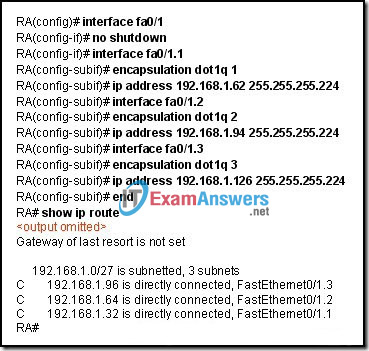
- The router will drop the packet.
- The router will forward the packet out interface FastEthernet 0/1.1.
- The router will forward the packet out interface FastEthernet 0/1.2.
- The router will forward the packet out interface FastEthernet 0/1.3.
- The router will forward the packet out interface FastEthernet 0/1.2 and interface FastEthernet 0/1.3
2. Which value determines if a switch becomes the central point of reference in the spanning tree topology?
- lowest bridge ID
- highest revision number
- lowest numeric IP address
- highest numeric MAC address
3. An administrator is troubleshooting a PC on the network which is suffering from slow and intermittent connectivity. The PC has a ping success rate to the default gateway of less than half the ping attempts. Other PCs on the switch can consistently ping the default gateway. The switch port is configured for auto duplex and the PC is configured for full duplex. What will commonly cause this problem?
- The PC is set to full duplex. The switch port fails to autonegotiate the duplex setting and defaults to half duplex, which causes a duplex mismatch.
- The switch traffic is exceeding available frame buffers. The result is that frames are being dropped.
- The PC and the default gateway have different bandwidth Ethernet ports.
- The default gateway is not on the same switch that the PC is.
4. What is the purpose of the switch command switchport access vlan 99?
- to enable port security
- to make the port operational
- to assign the port to a particular VLAN
- to designate the VLAN that does not get tagged
- to assign the port to the native VLAN (VLAN 99)
5. What three tasks should be performed before moving a Catalyst switch to another VTP management domain? (Choose three.)
- Select the correct VTP mode and version.
- Configure the switch with the name of the new management domain.
- Download the VTP database from the VTP server in the new domain.
- Configure the VTP server in the new domain to recognize the BID of the switch.
- Reset the VTP counters to allow the switch to synchronize with the other switches in the new domain.
- Verify that the switch has a lower configuration revision number than the other switches in the new domain.
6. Which method establishes an administrative connection for configuring the Linksys WRT300N wireless access point?
- Associate with the access point and then open a HyperTerminal session with the access point.
- Physically connect to the access point and then reboot the computer to launch the configuration software.
- From a computer in the same IP subnet as the access point, enter the default IP address of the access point in a web browser.
- Modify the TCP/IP properties of the computer connected to the access point so that it exists on the same network, and then reboot your computer to establish a connection.
7. How does a switch that is configured for 802.1Q trunking handle untagged frames that are received on a trunk port?
- The frames are dropped.
- The frames are assigned to the native VLAN.
- The frames are assigned to the default VLAN.
- The frames are assigned to the management VLAN.
8. In which mode is a VTP switch operating if it has been configured to only forward VTP advertisements?
- client
- root
- server
- transparent
9. Why is it important that the network administrator consider the spanning-tree network diameter when choosing the root bridge?
- The network diameter limitation is 9.
- BPDUs may be discarded because of expiring timers.
- The cabling distance between the switches is 100 meters.
- The network diameter must be set to the number of meters of the cable between the root bridge and its farthest connected switch.
10. Which feature is uniquely found in an access layer switch within a hierarchical network model?
- link aggregation
- Power over Ethernet
- access control lists
- Layer 3 routing capabilities
11. While configuring a new switch, a network administrator configures the switch as an HTTP server. What benefits does this configuration provide?
- This allows the switch to host web pages for the network.
- This allows remote VPN connections to the switch over the Internet.
- This is required if a web server or web farm is attached to the switch.
- This allows web-based configuration tools to be used with the switch.
12. Using the command copy tftp:backup.cfg startup-config, an administrator downloaded a saved configuration from a TFTP server to a switch. Why does the administrator not detect any changes in the switch configuration after the download completes?
- The command should have been copy startup-config tftp:backup.cfg.
- A backup configuration from a TFTP server cannot be copied directly into the startup-config.
- The command copy running-config startup-config should be used to save the changes on the switch.
- Downloading to the startup-config requires the switch to be reloaded in order for the configuration to take effect.
13. Why is it advisable that a network administrator use SSH instead of Telnet when managing switches?
- SSH uses TCP whereas Telnet does not.
- SSH encrypts only the username and password when logging in.
- SSH encrypts all remote management communications whereas Telnet does not.
- SSH sends a clear text message steam which reduces the bandwidth use for management.
14. Refer to the exhibit. A network has already been configured with VTP, using DLS1 as the VTP server for the VTP domain Cisco. What will happen when the DLS2 switch is connected to the DLS1 switch via a trunk link?
- Because the VTP domain is not configured on DLS2, nothing will happen.
- Because DLS2 is in client mode, it will be updated with the VLANs that are configured on DLS1.
- The MD5 digest on DLS2 does not match the one on DLS1, so an error message will be logged to the console.
- Because DLS2 has a higher revision number than DLS1 has, the VLAN information on DLS1 will be overwritten by the information on DLS2.
15. What information in an Ethernet frame is used by a Layer 2 switch to build its address table?
- source IP address
- source MAC address
- destination IP address
- destination MAC address
16. A wireless LAN access point will convert traffic between which two frame encapsulation types?
- 802.1 and 802.11
- 802.3 and 802.11
- 802.3 and 802.16
- 802.5 and 802.16
17. A network administrator is asked to connect four switches that are each configured with eight VLANs. Routers that have two FastEthernet ports each that support trunking are available. What is the minimum number of routers needed to interconnect traffic from all of the VLANs if trunking is allowed?
- 1
- 2
- 4
- 8
- 16
18. What are two characteristics of normal range VLANs? (Choose two.)
- not learned by VTP
- stored in vlan.dat file
- designed for service providers
- can contain ports used as trunks
- identified by a VLAN ID between 1 and 1005
19. What is the benefit of the auto-MDIX feature on a Cisco Catalyst switch?
- dynamically assigns a new management VLAN ID
- autonegotiates IP address information for initial management connections
- allows the use of straight-through patch cables regardless of connected device types
- places a port immediately in the forwarding state to reduce the time for the spanning tree to reconverge
20. What benefit does 802.1x provide to a wireless network?
- increased wireless range
- faster wireless throughput
- centralized user authentication
- quality of service to differentiate high priority traffic
21. Which configuration changes will increment the configuration revision number on the VTP server?
- configuring trunk links on the VTP server
- configuring or changing the VTP password
- configuring or changing the VTP domain name
- configuring or changing the VTP version number
- configuring or deleting a VLAN or creating a VLAN name
22. A wireless client is attempting to establish a connection with a wireless access point. What process does the client use to discover the access points which are available to it?
- probing
- beaconing
- association
- authentication
23. Refer to the exhibit. Each switch is shown with its MAC address. Which switch will be elected as the spanning-tree root bridge if the switches are configured with their default priority values?
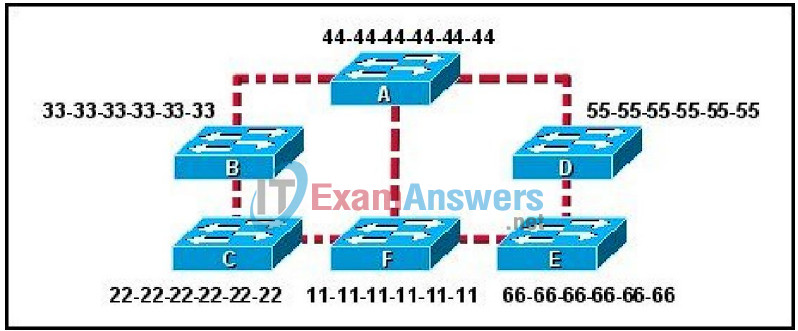
- switch A
- switch B
- switch C
- switch D
- switch E
- switch F
24. What is a function or characteristic of the native VLAN?
- It is the VLAN that supports untagged traffic on an 802.1Q trunk.
- It is always assigned to VLAN 1 for backward compatibility.
- It is always the same VLAN number for all trunks within an organization.
- It is used as the management VLAN throughout the entire switched network.
25. A network administrator must purchase new access layer switches to deploy across an existing hierarchical network that supports voice and data traffic. At a minimum, which two features should the new access layer switches support? (Choose two.)
- PoE
- QoS
- modular design
- Layer 3 support
- line speed forwarding rates
26. Which combination is required to establish a connection to initially configure the Linksys WRT300N wireless access device?
- a computer with a console connection to the WRT300N
- a computer with a wireless connection to the WRT300N
- a computer with an AUX port connection to the WRT300N
- a computer configured in the same IP subnet as the WRT300N and a direct cable connection to it
27. Refer to the exhibit. SW-T has been configured with a single trunking interface. Which VLANs will be allowed across the trunk?
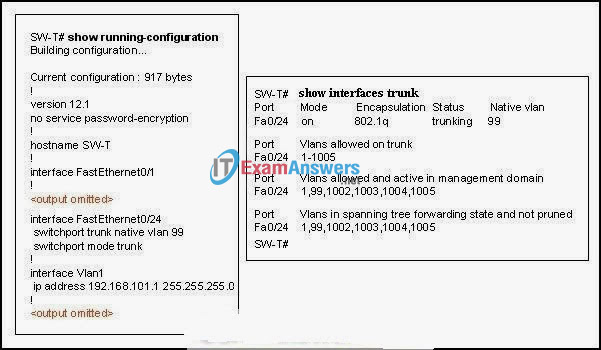
- Only VLAN 1 will be allowed across the trunk.
- All configured VLANs will be allowed across the trunk.
- Only the native VLAN will be allowed across the trunk.
- Only the the management and native VLANs will be allowed across the trunk.
- Only VLANs that are configured on the VTP server in the domain will be allowed across the trunk.
28. Refer to the exhibit. Hosts B and C attempt to transmit a frame at the same time, but a collision occurs. Which hosts will receive the collision jamming signal?
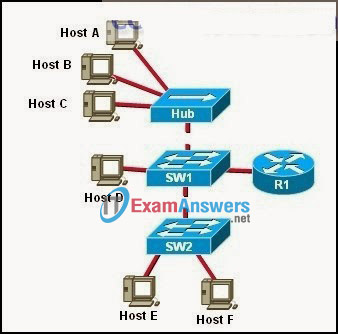
- all hosts that are shown
- only hosts B and C
- only hosts A, B, and C
- only hosts A, B, C, and D
- only hosts A, D, E, and F
- only hosts D, E, and F
29. Refer to the exhibit. The switch VTY lines have been properly configured, but PC1 is unable to remotely manage the switch. How can this problem be resolved?
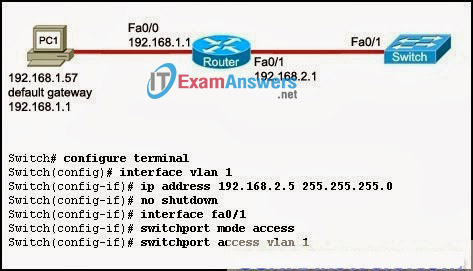
- Configure the Fa0/1 interface of the switch in trunk mode.
- Configure a default gateway on the switch.
- Configure the native VLAN on the switch.
- Configure the Fa0/1 interface of the switch to allow all VLANs.
30. Refer to the exhibit. The network administrator is planning five additional VLANs to be shared throughout the VTP domain on S3. What action should the administrator take before creating the additional VLANs?
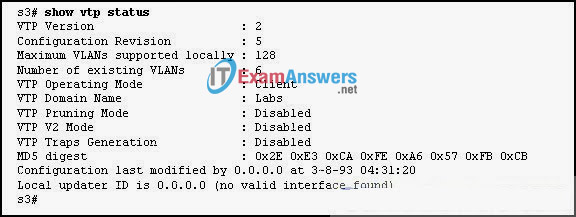
- Create the VLANs on a switch in VTP server mode and allow them to propogate to the other switches in the domain.
- Modify the configuration revision to 10 to support the additional VLANs.
- Enable the VTP pruning mode in order to create the VLANs on S3.
- Enable the VTP v2 mode.
31. Which switching method provides error-free data transmission?
- fragment-free
- fast-forward
- integrity-checking
- store-and-forward
32. Which wireless topology supports roaming from one access point to another?
- ESS
- BSS
- IBSS
- ad hoc
33. A wireless access point is configured for WPA2. Which encryption algorithm will all devices that connect to the access point be required to use?
- AES
- PPK
- PSK
- TKIP
- WEP
34. Where is the information of newly created VLANs stored on a switch?
- CPU
- flash
- NVRAM
- RAM
35. Refer to the exhibit. The configuration steps that are listed in the exhibit have been entered in switch S1 via the console. Subsequent attempts to telnet to the switch are not successful. What is causing the problem?

- The switch must be configured with SSH version 1.
- The transport input command must specify Telnet access.
- The RSA keys must be returned to zero before SSH will permit Telnet access.
- The ip domain-name command must also be entered in line configuration mode for the vty lines.
36. What is one disadvantage that 802.11a wireless has compared to 802.11g?
- Use of the 5GHz band requires much larger antennas.
- The OFDM modulation technique results in a slower data rate.
- There are fewer non-overlapping channels available to help reduce RF interference.
- The use of higher frequencies means that signals are more likely to be obstructed.
37. Why is MAC address filtering considered a poor choice in securing a WLAN?
- Available bandwidth is reduced.
- MAC addresses are easily spoofed.
- APs are more susceptible to DoS attacks.
- The payload encryption is easily broken.
38. What is the purpose of the Spanning Tree algorithm?
- It propagates VLAN configurations to other switches.
- It restricts broadcast packets to a single VLAN.
- It segments a network into multiple broadcast domains.
- It prevents loops in a switched network with redundant paths.
39. What are two benefits of a hierarchical network model over a flat network design? (Choose two.)
- reduced cost of equipment
- increased network availability
- elimination of equipment downtime
- reduced size of the physical network layout
- simplification of management and troubleshooting
- elimination of the need for Layer 3 functionality
40. What is the purpose of VLAN trunking?
- It improves network performance by reducing broadcast traffic.
- It selects the best path to transmit data in a switched network.
- It carries the traffic of multiple VLANs through a single link.
- It avoids spanning tree loops in a switched network.
41. Which two statements describe the operation of an access layer Ethernet switch? (Choose two.)
- Broadcasts are natively blocked by the switch.
- Subnetting is used by the switch to segment local networks.
- Frames that contain an unknown destination MAC address are dropped by the switch.
- The source MAC address within a frame is used by the switch to associate a port with that MAC address.
- Frames are directed by the switch from one port to another based on the destination MAC address within the frame.
- Data packets are forwarded by the switch from one port to another based on the destination IP address within the packet.
42. Which two types of traffic are always transmitted as untagged frames? (Choose two.)
- traffic that is assigned to the default VLAN
- traffic that is assigned to the native VLAN
- traffic from the voice VLAN on an IP phone
- Telnet, HTTP, or SSH traffic for switch management
- traffic that is leaving an access mode port that is connected to another switch
43. Which statement correctly describes a function of a Layer 2 switch?
- It routes packets between different LAN segments.
- It uses the destination MAC address to selectively forward a frame.
- It performs switching and filtering based on the destination network layer address.
- It drops a frame whose destination MAC address is not in the MAC address table.
44. Refer to the exhibit. The Layer 2 switching design that is shown has been implemented in a campus environment that is using Spanning Tree Protocol. All inter-switch links that are shown are trunks. Whenever an inter-switch link fails, the network takes nearly a minute to completely converge. How can the convergence time be reduced?
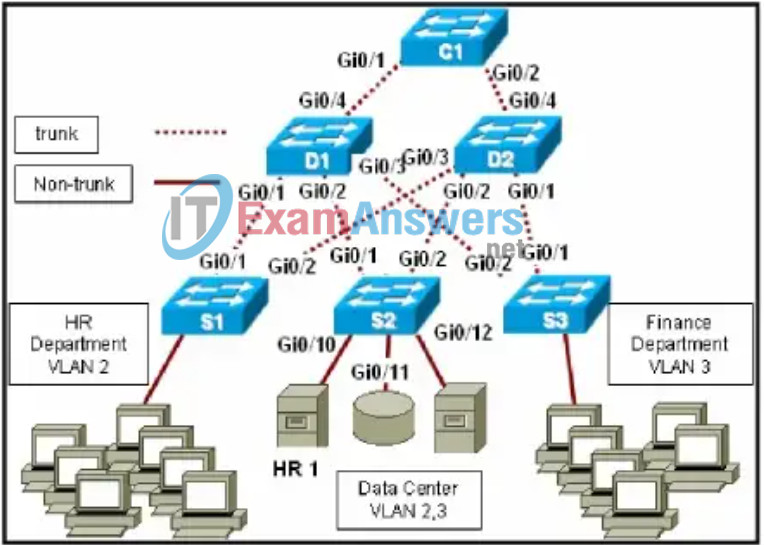
- Increase the capacity of the distribution and core trunk links to 10 Gb/s.
- Add a trunk link that directly connects D1 and D2.
- Use Layer 3 switching on the core switch.
- Implement Rapid Spanning Tree Protocol.
45. Refer to the exhibit. Hosts that are connected to switch SW1 are not able to communicate with hosts in the same VLAN that are connected to switch SW2. What should be done to fix the problem?
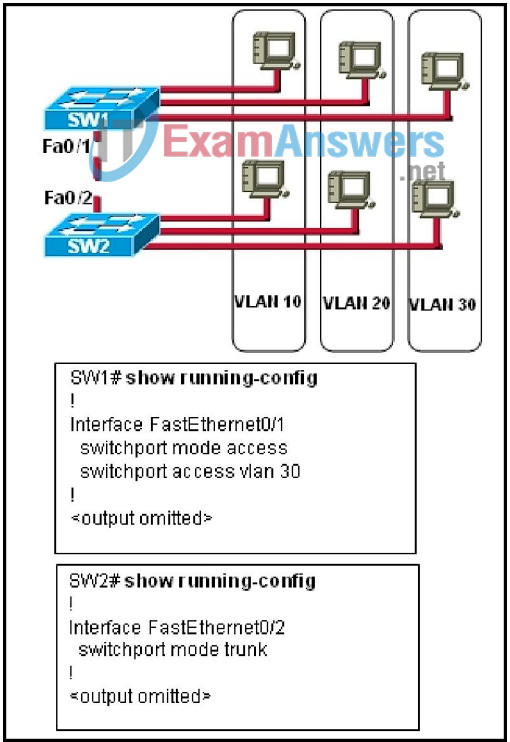
- Introduce a Layer 3 device in the topology.
- Configure both switches in VTP transparent mode to allow them to share VLAN information.
- Reconfigure the fa0/1 interface on switch SW1 with a static trunk configuration.
- Apply IP addresses that are in the same subnet to FastEthernet 0/1 on SW1 and FastEthernet 0/2 on SW2.
46. Refer to the exhibit. Which two statements are true about the operation of the interfaces? (Choose two.)
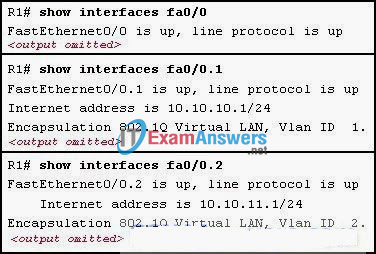
- Incoming traffic with VLAN ID 0 is processed by interface fa0/0.
- Incoming traffic that has a VLAN ID of 2 is processed by subinterface fa0/0.2.
- Both subinterfaces remain up with line protocol up, even if fa0/0 line protocol is down.
- Subinterfaces use unique MAC addresses by adding the 802.1Q VLAN ID to the hardware address.
- Traffic inbound on this router is processed by different subinterfaces, depending on the VLAN from which the traffic originated.
47. A network technician is attempting to configure 802.1q trunking on switch ports Fa0/5 through Fa0/10. Which set of commands will accomplish this task?
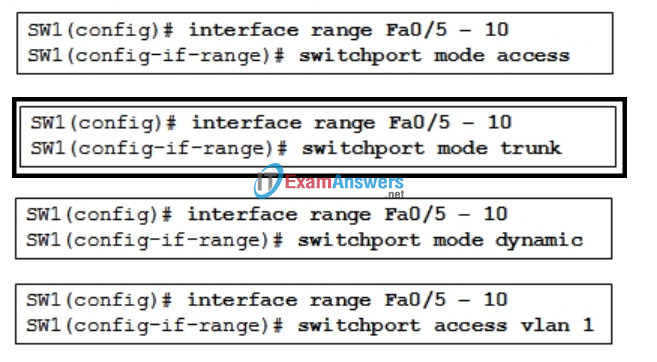
48. Refer to the exhibit. The teacher host is connected to port Fa0/7 on switch STW. A student has decided to share access to the Internet by attaching a hub and laptop to STW as shown. What will be the result of the student making this connection?
- The Fa0/7 port of STW will be shutdown.
- The student will gain full access to the Internet.
- Both the teacher and student will be able to receive data but only the teacher will be able to send.
- The frames from the laptop will be dropped, but the teacher host will maintain connectivity with the network.
49. A network administrator configures a switch port with the command switchport mode dynamic auto. What is the resulting behavior of the switch port?
- The switch port is able to trunk if the remote switch port is set to auto.
- The switch port is able to trunk if the remote switch port is set to desirable.
- The switch port will be disabled if it is unable to successfully negotiate trunking.
- A successful trunk will be established if the remote switch is non-Cisco but the port is configured for trunking.
50. Which STP port type can only appear once on a segment, and must be present in order for traffic to flow on that segment?
- non-root port
- disabled port
- designated port
- non-designated port
51. Refer to the exhibit. VLAN 10 has been configured on the VTP server. Users who are assigned to VLAN 10 are connected as shown in the exhibit. On the basis of the outputs that are provided, which group of users will be able to communicate with the users on VLAN 10 on SW1?
- all the users who are connected only to SW2
- users on VLAN 10 who are connected only to SW3
- users on VLAN 10 who are connected only to SW4
- users on VLAN 10 who are connected to both SW3 and SW4
52. Refer to the exhibit. Switches S2 and S3 are properly connected using an ethernet cable. A network administrator has configured both switches with VTP, but S3 is unable to propagate VLANs to S2. What could be the reason for this?
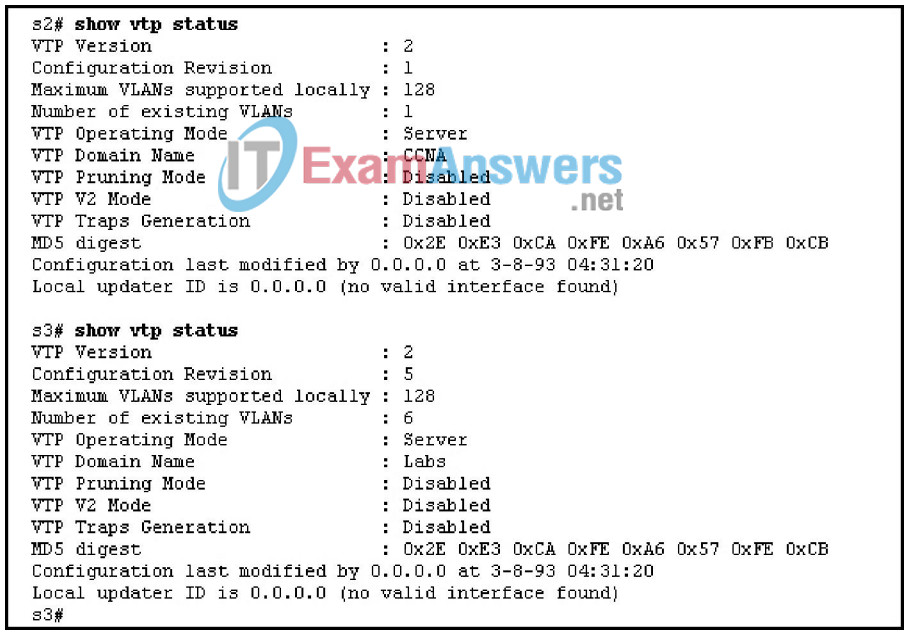
- The VTP configuration revision is different on both switches.
- The VTP domains are different on both switches.
- VTP pruning is disabled.
- VTP v2 is disabled.
53. In a three-layer hierarchical network design, which distribution layer function delineates broadcast domains?
- routing between VLANs
- aggregating traffic flows
- providing redundant links
- reducing the network diameter
54. Which parameter is used to uniquely identify one wireless network from another?
- SSID
- OFDM
- WEP
- DSSS
55. Which three statements are correct concerning the default configuration of a new switch? (Choose three.)
- It is configured in VTP server mode.
- STP is automatically enabled.
- The first VTY line is automatically configured to allow remote connections.
- VLAN1 is configured with a management IP address.
- All switch ports are assigned to VLAN1.
- The enable password is configured as cisco.
56. Refer to the exhibit. How is port Gi1/1 on SWT-A functioning in the spanning-tree topology?
- It is sending and receiving data frames.
- It is receiving BPDUs, but not sending data frames.
- It is participating in the election process by forwarding the BPDUs it receives.
- It is receiving BPDUs and populating the MAC address table, but not sending data.
57. Which statement describes the use of voice VLANs in Cisco IP telephony?
- The voice VLAN carries both tagged and untagged traffic.
- The voice VLAN carries untagged traffic having special QoS markings.
- The voice VLAN must be configured on the switch port to which the IP phone attaches.
- Data and voice frames are tagged with same VLAN ID between the IP phone and the switch when a voice VLAN is configured.
58. Refer to the exhibit. The VTP domain has been configured as shown in the exhibit. The network technician accidentally configured the VTP server as a VTP client. After the technician reloaded the switches, all users in the VTP domain started to complain that they lost connectivity to the users on the same VLANs that are connected to other switches. What should be done in the future to prevent losing all VLAN configurations in a VTP domain?
- Configure all switches in VTP transparent mode and copy the VLAN configuration into flash.
- Configure all switches in the network as VTP clients and copy the VLAN configuration into NVRAM.
- Create a new domain and configure a second switch as a VTP server to take over in case of a primary VTP server failure.
- In the same domain, configure a second switch as a VTP server to take over in case of a primary VTP server failure.
59. Refer to the exhibit. How does SW1 manage traffic coming from Host A?
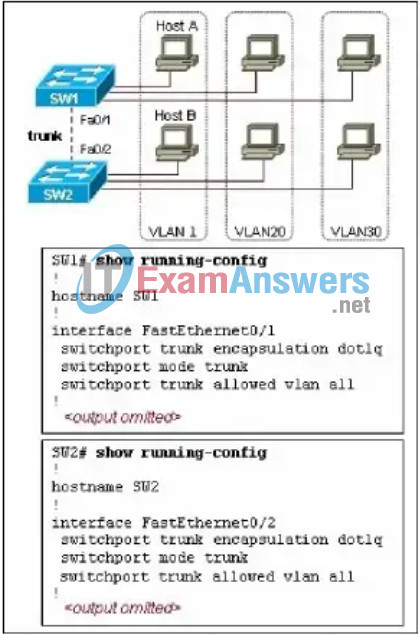
- SW1 drops the traffic because it is untagged.
- SW1 leaves the traffic untagged and forwards it over the trunk.
- SW1 tags the traffic with the lowest VLAN ID value and forwards it over the trunk link.
- SW1 encapsulates the traffic with 802.1Q encapsulation and forwards it over the trunk link.
60. What impact does the use of the mdix auto configuration command have on an Ethernet interface on a switch?
- automatically detects duplex settings
- automatically detects interface speed
- automatically detects copper cable type
- automatically assigns the first detected MAC address to an interface
61. Which CLI mode allows users to access all device commands, such as those used for configuration, management, and troubleshooting?
- user EXEC mode
- privileged EXEC mode
- global configuration mode
- interface configuration mode
62. What will be the effect of the command S1# copy system:running-config tftp://172.16.2.155/tokyo-config?
- The IOS will be copied to the TFTP server.
- The configuration file named tokyo-config will overwrite the startup configuration file on S1.
- The running configuration file on S1 will be saved via TFTP to a file named tokyo-config.
- The contents of NVRAM on S1 will become the startup configuration file on the tokyo switch.
63. Company policy requires disabling the command history buffer on network devices. An administrator enters terminal no history size at the command prompt on a Cisco Catalyst switch and receives no error messages back, but the command history buffer is still available. What is the problem?
- The command contained a syntax error.
- The Cisco IOS version does not support disabling the command history buffer.
- The command history can only be disabled on a router, not a switch.
- The size parameter reset the default buffer size but did not disable access to the buffer.
64. A network administrator is implementing VTP in a large campus LAN that contains one hundred switches. What are valid considerations for reliability and administration?
- Using server mode on a single master switch and client mode on all other switches will provide the most fault tolerance for retaining VLAN information in all switches if power is lost on the network.
- Using transparent mode on all switches will allow for efficient administration and prevent VLAN data loss from the loss of any single switch.
- Configuring several switches in server mode will allow all VLANs to be entered from a single switch and preserve VLAN data if any of the switches or connections are lost.
- Configuring one primary and one backup switch in server mode and all other switches in transparent mode will provide fault tolerance for the VLAN data and allow for efficient distribution of the VLAN configurations to all switches.
65. Refer to the exhibit. Switch SW-A is to be used as a temporary replacement for another switch in the VTP Student domain. What two pieces of information are indicated from the exhibited output? (Choose two.)
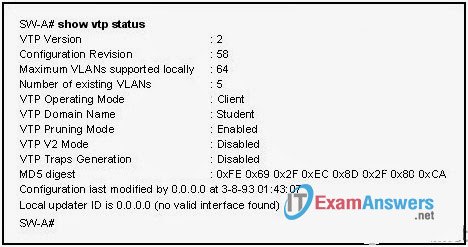
- The other switches in the domain can be running either VTP version 1 or 2.
- There is a risk that the switch may cause incorrect VLAN information to be sent through the domain.
- VTP will block frame forwarding on at least one redundant trunk port that is configured on this switch.
- VLAN configuration changes made on this switch will be sent to other devices in the VTP domain.
- This switch will update its VLAN configuration when VLAN changes are made on a VTP server in the same domain.
66. What is the purpose of issuing the command switchport mode access on a switch interface?
- disable port security
- make the port operational
- override the default port behavior
- force the port to be a part of a single vlan
67. Refer to the exhibit. What will be the result of the commands that are shown in the exhibit?

- Only clients on VLAN 2 will be able to use DHCP for addressing.
- DHCP server responses will only be permitted on interface Fa0/2.
- Only 100 clients are permitted to request DHCP addresses on VLAN 2.
- Client requests for DHCP addresses will be filtered out if the requests are not received on interface Fa0/2.
68. Refer to the exhibit. What is the result of issuing these commands?

- The enable password will be set.
- The password will be set for the first Telnet connection.
- The password will be set for the console connection.
- The password will be set for the auxiliary connection.
69. Refer to the exhibit. After entering the commands in the exhibit, the administrator receives a “password required, but none set” message when attempting to connect to S1. What is the problem?

- The enable secret password was not set.
- S1 does not have login configured on the vty lines.
- S1 does not have a password configured for the vty lines.
- The crypto key is not properly configured to generate passwords.
- The VLAN1 interface has not be enabled with the no shutdown command.
70. Refer to the exhibit. Which Spanning Tree Protocol version is in effect?
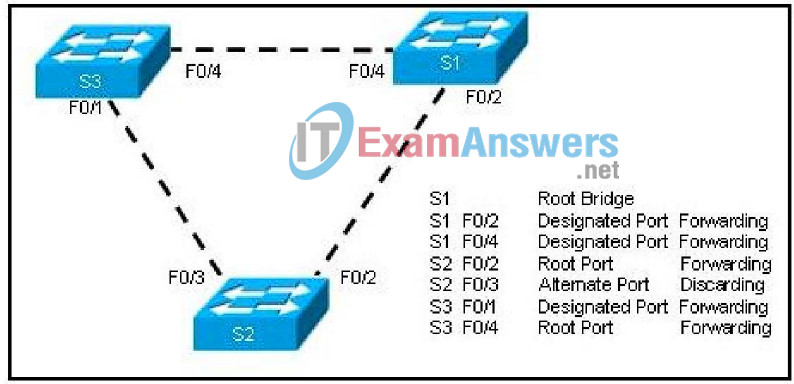
- Per VLAN Spanning Tree (PVST)
- Per VLAN Spanning Tree + (PVST+)
- Common Spanning Tree (CST)
- Rapid Spanning Tree Protocol (RSTP)
- Multiple Spanning Tree Protocol (MSTP)
71. Refer to the exhibit. A network administrator has segmented the network into two VLANs and configured Router1 for inter-VLAN routing. A test of the network, however, shows that hosts on each VLAN can only access local resources and not resources on the other VLAN. What is the most likely cause of this problem?
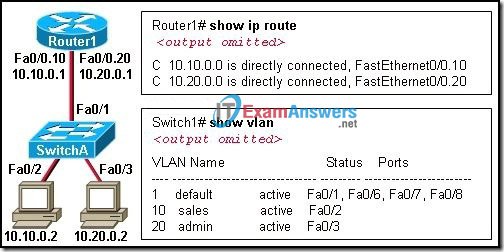
- Switch port Fa0/1 is not trunking.
- Router interface Fa0/0 is possibly down.
- No routing protocol is configured on Router1.
- One of the router subinterfaces is possibly down.
72. Refer to the exhibit. Hosts A and B, connected to hub HB1, attempt to transmit a frame at the same time but a collision occurs. Which hosts will receive the collision jamming signal?
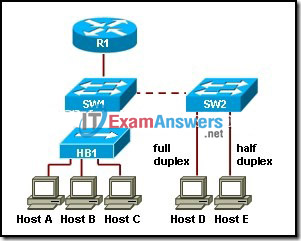
- only hosts A and B
- only hosts A, B, and C
- only hosts A, B, C, and D
- only hosts A, B, C, and E
73. Refer to the exhibit. Which three options correctly identify information that could be associated with this output?(Choose three.)

- Interface FastEthernet3/0/0 is subinterfaced.
- A non-proprietary trunking protocol is in use.
- The configuration is appropriate for a router-on-a-stick network design.
- A shutdown command has been applied to interface FastEthernet3/0/0.
- Interface FastEthernet3/0/0.3 is mapped to the default management VLAN.
- An IP address should be applied to FastEthernet3/0/0 for correct data routing.
74. What VLANs are allowed across a trunk when the range of allowed VLANs is set to the default value?
- only the management VLAN
- all VLANs except the extended range VLANs
- all VLANs except 1 and 1002-1005
- all VLANs
75. Refer to the exhibit. VTP pruning is enabled in the VTP domain that is shown. How will switch ST-1 handle Layer 2 broadcast traffic originating from host A on switch ST-C?
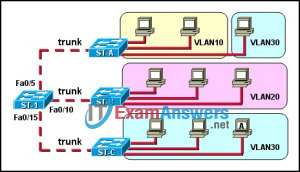
- It will be dropped.
- It will be forwarded out port Fa0/5 only.
- It will be forwarded out ports Fa0/5 and Fa0/10.
- It will be forwarded out ports Fa0/5, Fa0/10, and Fa0/15.
76. In which mode is a VTP switch operating if it does not allow for the creation of local VLANs but it does accept VLAN updates from other switches in the same domain?
- client
- root
- server
- transparent
77. Refer to the exhibit. A new host needs to be connected to VLAN 1. Which IP address should be assigned to this new host?
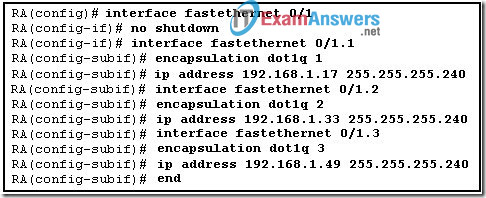
- 192.168.1.11 /28
- 192.168.1.22 /28
- 192.168.1.33 /28
- 192.168.1.44 /28
- 192.168.1.55 /28
78. Refer to the exhibit. An administrator documented the output of a CAM table from an Ethernet switch as shown. What action will the switch take when it receives the frame shown at the bottom of the exhibit?
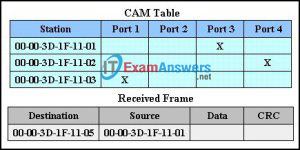
- discard the frame
- forward the frame out port 2
- forward the frame out port 3
- forward the frame out all ports
- forward the frame out all ports except port 3
- add station 00-00-3D-1F-11-05 to port 2 in the forwarding table
79. When port security is used on a switch, which violation mode will cause an SNMP trap to be sent and traffic to be dropped when the number of secure MAC addresses for a port is reached?
- sticky
- protect
- restrict
- shutdown
80. Refer to the exhibit. If switch SW1 is configured with the four VLANs as shown in the exhibit, how many physical interfaces are needed on router R1 to configure inter-VLAN routing using subinterfaces?
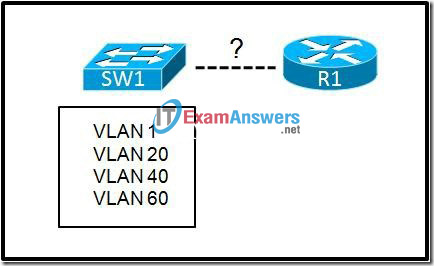
- zero
- one
- two
- four
81. Refer to the exhibit. What can be determined from the configuration of this wireless device?
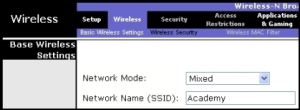
- This configuration is commonly found in an ad hoc network.
- All wireless devices that are connected to this access point must have the SSID of Academy.
- Any wireless clients that are attached to this access point would have the same IP address and SSID.
- Any wireless clients that are attached to this access point must be connected using the 802.11n WAN protocol.
82. Which type of traffic can still be received on a switch interface that is in STP blocking mode?
- BPDU frames
- multicast frames
- broadcast frames
- Layer 3 packets
83. What is the purpose of configuring a switch port as a trunk port?
- to control the broadcast domain size
- to eliminate the collisions that result from multiple VLANs
- to transmit data from multiple VLANs through a single port
- to increase the bandwidth between the switch and its upstream device
84. Refer to the exhibit. Which statement is true about the status of interface Fa0/1?

- The interface is not configured to transmit data.
- The interface is configured to transmit data at 10 Mb/s speed.
- The interface is configured to transmit data in half-duplex mode.
- The interface is configured to use HDLC encapsulation to transmit data.
85. Refer to the exhibit. What is the effect of setting the security mode to WEP on the Linksys integrated router?
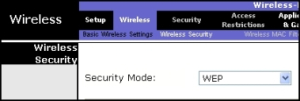
- WEP identifies the wireless LAN.
- WEP allows the access point to inform clients of its presence.
- WEP translates IP addresses into easy-to-remember domain names.
- WEP encrypts data between the wireless client and the access point.
- WEP translates an internal address or group of addresses into an outside, public address.
86. Refer to the exhibit. Which two switch interfaces would be RSTP edge ports? (Choose two.)
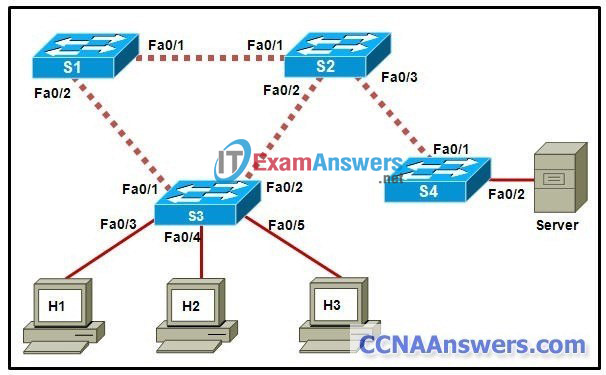
- switch S1, Fa0/1
- switch S3, Fa0/5
- switch S4, Fa0/1
- switch S2, Fa0/3
- switch S4, Fa0/2
- switch S3, Fa0/2
87. Refer to the exhibit. Switch SWA is not processing VTP advertisments from switch SWB. What can done to correct the error?
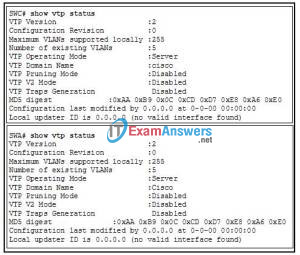
- Change the hostname of SWC to SWA.
- Change the hostname of switch SWA to SWC.
- Change the domain name on switch SWA to cisco.
- Change the enable password on both switches to Cisco.
88. A network administrator is planning the upgrade of an enterprise LAN to feature Layer 3 support for the application of data security policies, aggregated links, and redundant devices and links. Which switches in the hierarchical three-layer design model support these network requirements?
- core switches
- access switches
- backbone switches
- distribution switches
89. The global configuration command ip default-gateway 172.16.100.1 is applied to a switch. What is the effect of this command?
- The switch will have a management interface with the address 172.16.100.1.
- The switch can be remotely managed from a host on another network.
- The switch can communicate with other hosts on the 172.16.100.0 network.
- The switch is limited to sending and receiving frames to and from the gateway 172.16.100.1.
90. Which type of VLAN would accommodate untagged traffic on a 802.1q trunk port?
- data VLAN
- native VLAN
- untagged VLAN
- management VLAN
91. Refer to the exhibit. Router R1 is connected to a switch through a trunk. What two ways are indicative of how the router handles incoming VLAN traffic? (Choose two.)
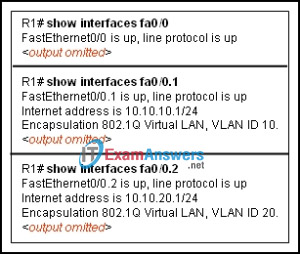
- Data from VLAN 20 is not being routed.
- Incoming traffic with VLAN ID 1 is processed by interface Fa0/0.
- Incoming traffic that has a VLAN ID of 10 is processed by subinterface Fa0/0.1.
- VLAN traffic is processed on the subinterfaces even if Fa0/0 line protocol goes down.
- The router uses a unique MAC address on VLAN 10 and 20 by adding the 802.1Q VLAN ID to the hardware address.
- Traffic inbound on this router is processed by different subinterfaces depending on the VLAN from which the traffic originated.
92. Refer to the exhibit. Users complain that they do not have connectivity to the web server that is connected to SW1. What should be done to remedy the problem?
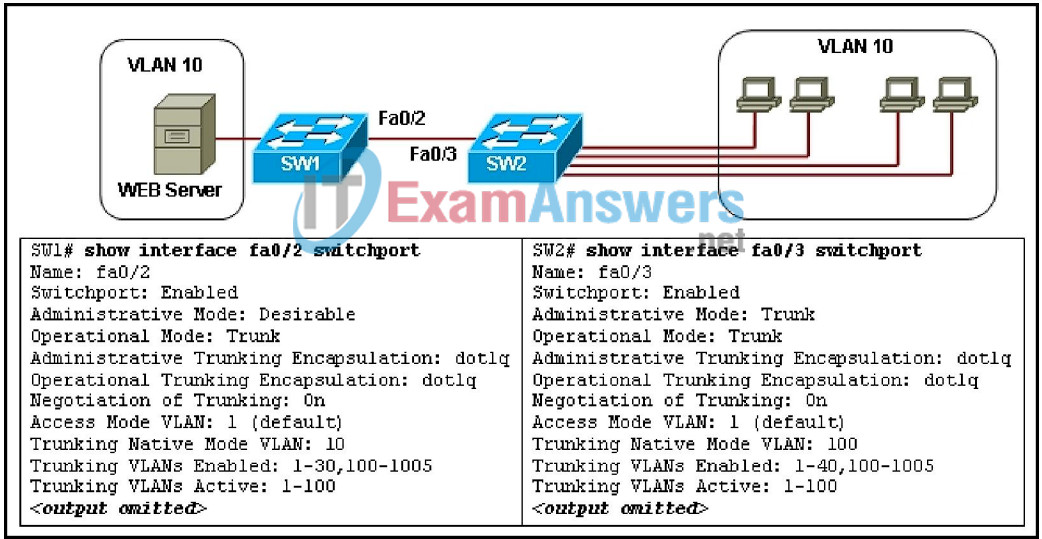
- Allow all VLANs on the trunk link.
- Configure VLAN 100 as the native VLAN for SW1.
- Configure the trunk port in trunk mode on SW1.
- Attach the web server to a router and configure inter-VLAN routing.
93. Refer to the exhibit. VLAN 20 was recently added on the network. Users on VLAN 20 on SW1 start complaining that they do not have connectivity to the users on the same VLAN on switch SW2. What should be done to remedy the problem?
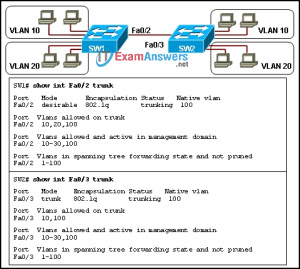
- Configure the trunk port in a desirable mode on SW2.
- Include VLAN 20 in the list of allowed VLANs on the trunk link on SW2.
- Configure VLAN 1 to be the native VLAN for both networks on SW1 and SW2.
- Remove VLAN 20 from the allowed VLANs on the trunk link on SW2, an action that will enable all VLANs on the trunk link.
94. Which statement correctly describes an IBSS?
- Wireless stations communicate with a single access point.
- Wireless stations communicate directly with each other, without an access point.
- Wireless stations communicate with multiple access points, each with the same SSID.
- Wireless stations communicate with multiple access points, each with a different SSID.
95. Which two operations can be performed from the boot loader command line of a Cisco Catalyst switch? (Choose two.)
- change hostname
- view active VLANs
- reinstall IOS image
- format flash file system
- show MAC address table
96. Refer to the exhibit. A network administrator enters the displayed commands to configure VLAN 30. What is the result of running these commands?
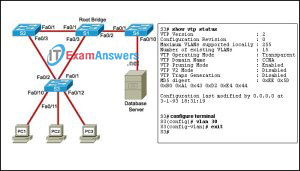
- VLAN 30 will be added to S1, S2, and S3, but not to S4.
- VLAN 30 will be pruned from the VLAN database of S3.
- VLAN 30 will be added to the VLAN database of S3 but will not be propagated to S4, S2 or S1.
- VLAN 30 will not be added to the VLAN database of S3 and an error message will be displayed.
97. Refer to the exhibit. A network administrator issues the show interfaces fastEthernet 0/8 switchport command to check the status of the port. What can be concluded from the output?
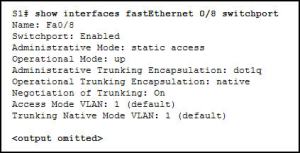
- Port Fa0/8 is configured as a trunk with 802.1q encapsulation.
- Port Fa0/8 is configured as a trunk in VLAN 1.
- Port Fa0/8 is configured in access mode and associated with VLAN 1.
- Port Fa0/8 is configured as a trunk and VLAN 1 is a native VLAN for the trunk.
98. Refer to the exhibit. R1 is configured for traditional inter-VLAN routing. R1 can ping computer 3 but cannot ping computer 1. What is a possible cause for this failure?
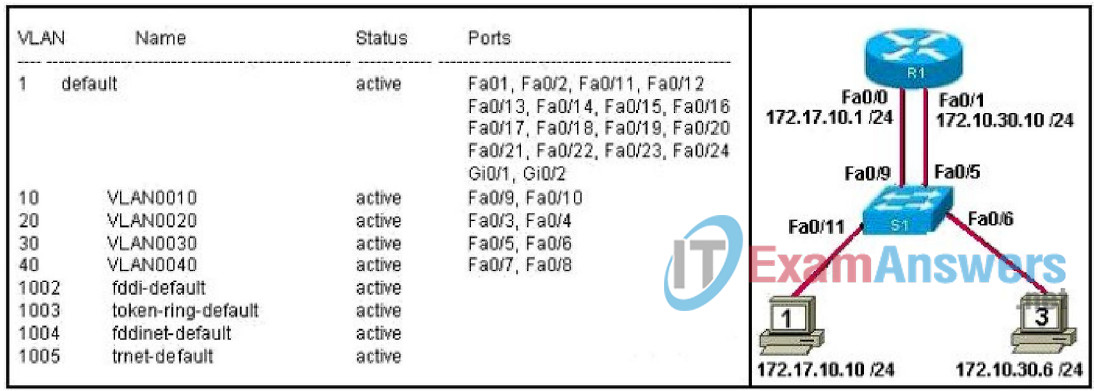
- S1 port Fa0/11 is in the wrong VLAN.
- R1 does not have an active routing protocol.
- The IP address of computer 1 is in the wrong logical network.
- Router interface Fa0/0 has the wrong trunk encapsulation type configured.
99. Refer to the exhibit. What will allow a host on VLAN 40 on switch X to communicate with a host in VLAN 40 on switch Y?
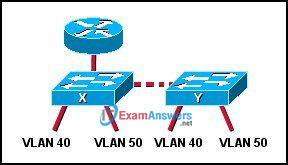
- QoS
- routing
- trunking
- VPN
100. Refer to the exhibit. Hosts PC_A and PC_B send traffic simultaneously, and the frames from the transmitting stations collide. What is the last device to receive the collision?
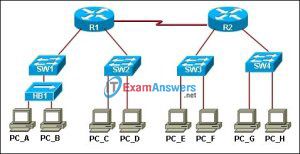
- hub HB1
- switch SW1
- router R1
- switch SW2
- router R2
- switch SW4
101. Refer to the exhibit. The hosts connected to switch SW1 are not able to communicate with the hosts in the same VLANs connected to switch SW2. What should be done to fix the problem?
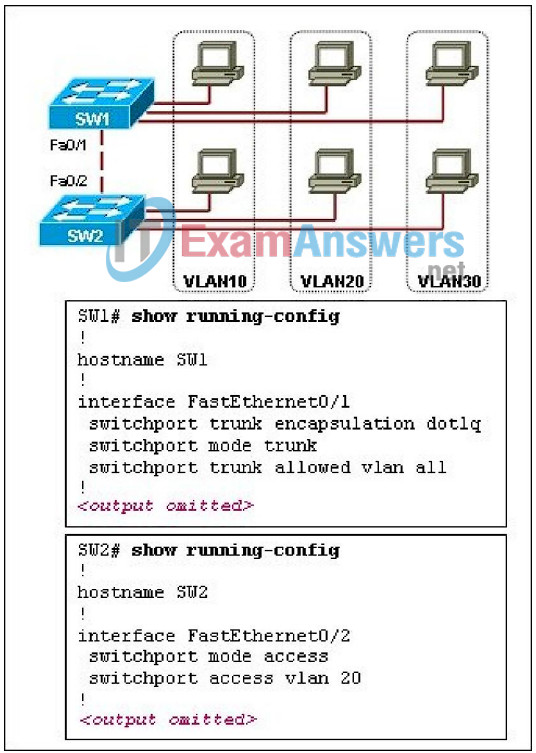
- Configure VLANs with different VLAN IDs on switch SW2.
- Reconfigure the trunk port on switch SW2 with static trunk configuration.
- Introduce a Layer 3 device or a switch with Layer 3 capability in the topology.
- Apply IP addresses that are in the same subnet to the interfaces used to connect SW1 and SW2
102. Refer to the exhibit. What happens when a frame from a source MAC address different from 00a8.d2e4.ba27 reaches switch port 0/5?

- The frame is dropped.
- The port is shut down.
- An error message is displayed.
- FastEthernet port 0/5 will show an err-disabled message
103. Refer to the exhibit. A new host needs to be connected to VLAN 3. Which IP address should be assigned to this new host?
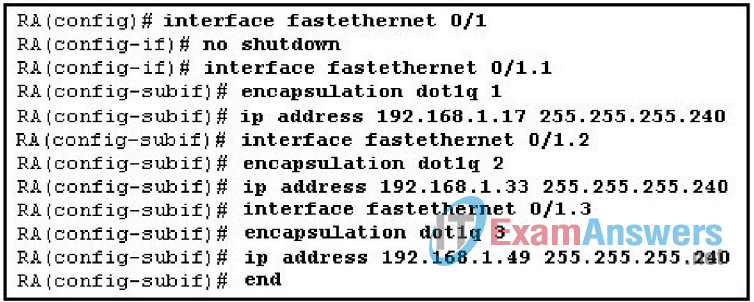
- 192.168.1.22 /28
- 192.168.1.31 /28
- 192.168.1.32 /28
- 192.168.1.52 /28
- 192.168.1.63 /28
104. What are two requirements for configuring inter-VLAN routing using the router-on-a-stick model? (Choose two.)
- Each subinterface should be configured with its own IP address, subnet mask, and unique VLAN assignment.
- The physical interface of the router must be connected to a trunk link on the adjacent switch.
- The number of physical interfaces on the router should match the number of VLANs.
- Different static VLANs should be assigned to different interfaces of the router.
The router should be configured as the VTP server.
105. Refer to the exhibit. A network administrator has segmented the network into two VLANs. The connected hosts can only access resources in their own VLAN. What is the most scalable and cost effective solution to allow inter-VLAN communication in this network?
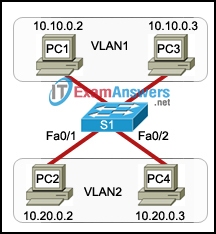
- Replace S1 with a router that has one FastEthernet interface for each PC.
- Add a second switch and divide the PCs so that each VLAN is connected to its own switch.
- Configure a router with two subinterfaces on one of its FastEthernet ports and connect it to S1 using a trunk link.
- Connect a router to a port on S1 and assign the IP address of VLAN1 to the connecting router interface.
106. Refer to the exhibit. Users A and B are reporting intermittent connectivity problems. Pre-installation surveys showed strong signal strength from the AP locations to the client locations. Outside electrical interference has been eliminated. What will fix the problem?
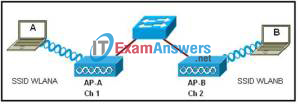
- Relocate the APs closer to each other.
- Increase the distance between the clients.
- Change the channel on AP-B to 6 or 11.
- Place AP-A and AP-B on the same wireless channel
107. Refer to the exhibit. The network consists of four hubs and a switch. The hosts connected to each hub are assigned addresses in the respective VLAN as shown. PC1 on VLAN 1 becomes infected with a virus and initiates a continuous IP broadcast. Which hubs will receive the broadcasts?
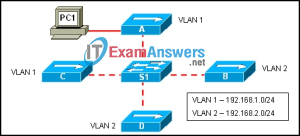
- Hub A
- Hubs A and B
- Hubs A and C
- Hubs A, B, C, and D
108. Refer to the exhibit. Each switch is configured to participate in STP for VLANs 1, 10, 20, and 30. Which switch will become the root for VLAN 20?
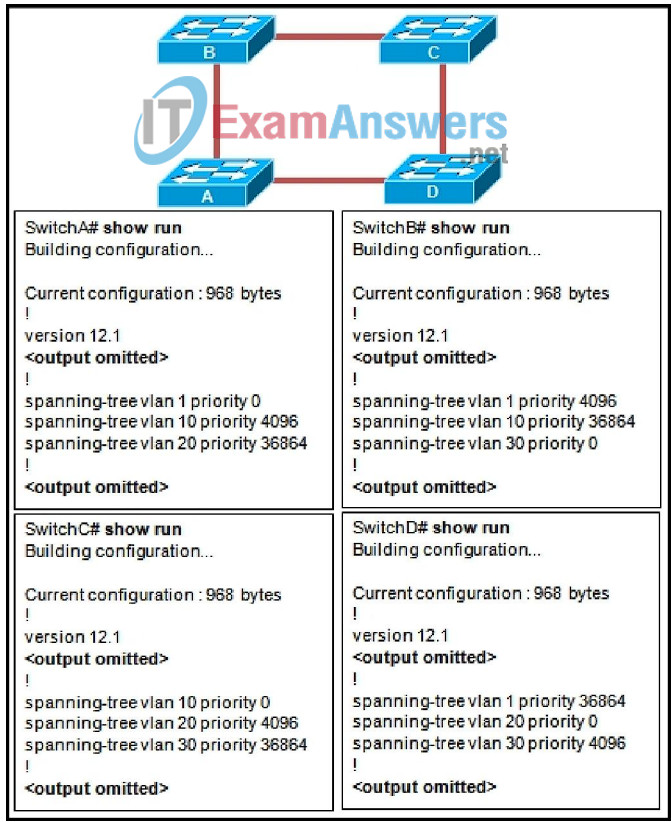
- A
- B
- C
- D
109. Refer to the exhibit. Which two settings show the default value of VTP configuration on a Cisco 2960 switch? (Choose two.)

- revision number
- existing VLANs
- operating mode
- domain name
- pruning mode
110. What type of message do wireless clients transmit when they are searching for a specific wireless network?
- probe
- beacon
- associate
- authenticate
111. A network administrator enters the enable command at the Switch> prompt of a new switch. What mode will the switch enter?
- setup mode
- configuration mode
- privileged EXEC mode
- user EXEC mode
- ROMMON mode
- interface mode
112. Refer to the exhibit. The network administrator needs to remove the east-hosts VLAN and use the switch port from that VLAN in one of the existing VLANs. Which two sets of commands should be used when completely removing VLAN 2 from S1-Central while leaving the switch and all its interfaces operational? (Choose two.)
- S1-Central# reload
S1-Central# erase flash:
S1-Central# delete flash:vlan.dat - S1-Central# configure terminal
S1-Central(config)# no vlan 2 - S1-Central# configure terminal
S1-Central(config)# interface fastethernet 0/1
S1-Central(config-if)# switchport access vlan 3
113. Why is priority configured in 4096 increments when using PVST+?
- Use of the extended bridge ID leaves only four bits for the bridge priority.
- It is only a recommended value and could be any number between 1 and 65535.
- PVST+ requires the use of values that can be divided equally into 32768 and not leave a remainder.
- The MAC address uses eight bytes of the bridge ID leaving only two bytes for the bridge priority value.
114. Refer to the exhibit. A network administrator is configuring RT1 for inter-VLAN routing. The switch is configured correctly and is functional. Host1, Host2, and Host3 cannot communicate with each other. Based on the router configuration, what is causing the problem?
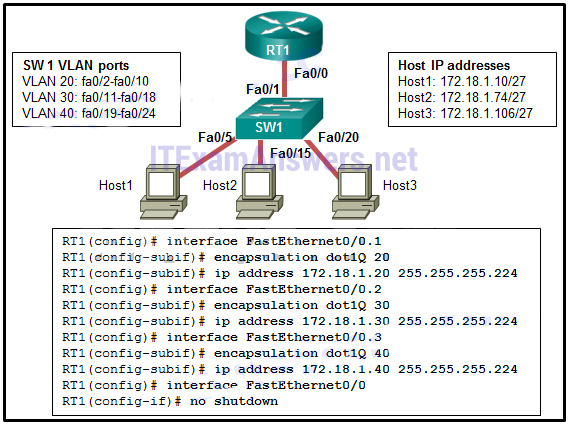
- Interface Fa0/0 is missing IP address configuration information.
- IP addresses on the subinterfaces are incorrectly matched to the VLANs.
- Each subinterface of Fa0/0 needs separate no shutdown commands.
- Routers do not support 802.1Q encapsulation on subinterfaces
115. What happens when the crypto key zeroize rsa command is entered on a switch configured with thetransport input ssh command on the vty lines?
- A new RSA key pair is created.
- The switch defaults to allowing Telnet connections only.
- The switch is no longer able to make SSH connections as an SSH client.
- The switch allows remote connections only after a new RSA key pair is generated
116. Refer to the exhibit. What does “LEARNING” mean as it relates to the Spanning Tree Protocol?
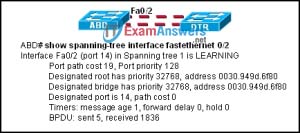
- The switch is sending and receiving data frames.
- The switch is not receiving BPDUs, but is sending and receiving data.
- The switch is participating in the election process by forwarding the BPDUs it receives.
- The switch is receiving BPDUs and populating the MAC address table, but not sending data.
117. What does TKIP have in common with AES?
- Both encrypt Layer 2 payloads.
- Both authenticate using a shared key.
- They both use sequence numbers to ensure that all packets arrive.
- They both use data from the MAC header to verify the integrity of the data.
118. What operational change will occur if an 802.11b client associates with an access point that is currently supporting clients utilizing 802.11g?
- The 802.11g clients will disassociate from the AP.
- The 802.11g clients will operate at reduced speeds.
- The 802.11b client will never gain access to the channel.
- The 802.11b client will not be able to establish an IP session with any of the other 802.11g clients.
119. Refer to the exhibit. A network administrator has segmented the network into two VLANs and configured R1 and S1 as displayed. However, PC1 is unable to access PC2. What is the likely problem?
- No routing protocol is configured on R1.
- The Fa0/1 port of S1 is not a trunk port.
- The default gateway address is not set on S1.
- Only one physical link between S1 and R1 is configured for inter-VLAN routing.
120. A network administrator issued the erase nvram: command on a switch. What will be the outcome of the command?
- It will clear the contents of the MAC table.
- It will clear the contents of the VLAN database.
- It will clear the contents of the startup configuration file.
- It will clear the contents of the running configuration file.
121. Refer to the exhibit. The network administrator wants to allow both SSH and Telnet connections to Switch1. However, the SSH connections fail. What is the most likely cause of this problem?

- The RSA key has been removed.
- SSH has been configured on the wrong line.
- The transport input command is applied incorrectly.
- The domain name has been configured in the wrong configuration mode.
122. Refer to the exhibit. What would happen if the network administrator moved the network cable of Host A from interface Fa0/1 to Fa0/3 on switch SW1?
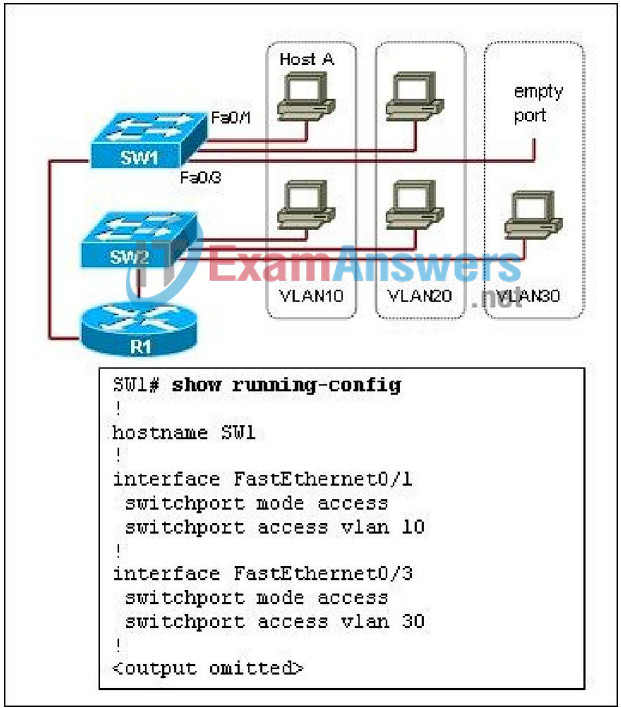
- Host A remains a member of VLAN 10, because the router is routing traffic between VLANs.
- Host A is no longer a member of VLAN 10, because port Fa0/3 has been manually assigned to VLAN 30.
- Host A remains a member of VLAN 10, because the switch provides dynamic VLAN assignment for the port.
- Host A maintains connectivity to all members of VLAN 10, because it is connected to the same physical network.
- Host A is no longer a member of VLAN 10, but because port Fa0/3 was unused, it is now a member of VLAN 1.
123. What identifier in the BPDU creates a unique BID for a switch?
- IP address
- MAC address
- bridge priority
- VLAN ID
- port priority
124. Refer to the exhibit. The devices in the network are operational and configured as indicated in the exhibit. However, hosts B and D cannot ping each other. What is the most likely cause of this problem?
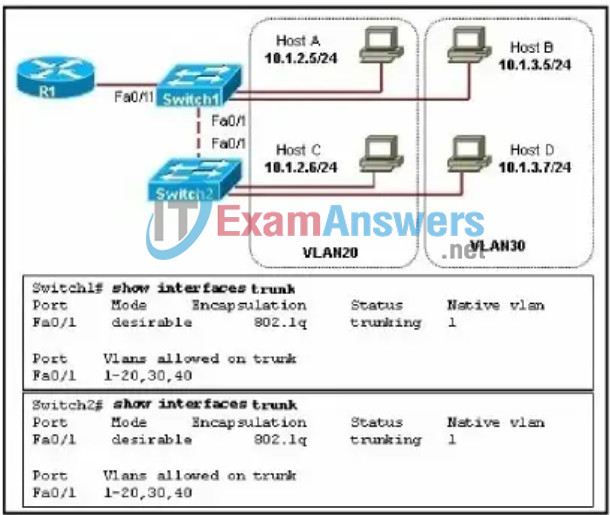
- The link between the switches is up but not trunked.
- The Fa0/11 interface of Switch1 is not configured as a trunk.
- Hosts B and D are configured with IP addresses from different subnets.
- VLAN 20 and VLAN 30 are not allowed on the trunk between the switches.
125. Refer to the exhibit. Both switches are interconnected via a trunk link. Host A and host B are on the default VLAN but are not able to exchange traffic. What should be done to fix the problem?
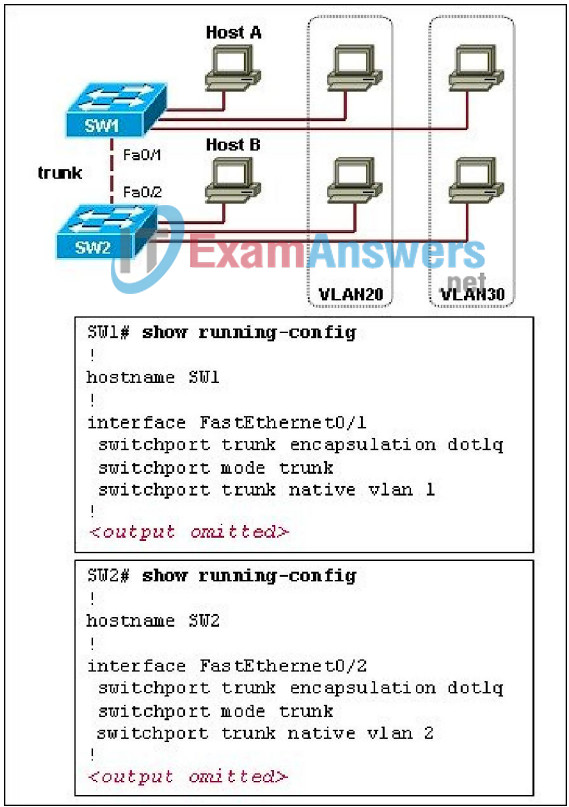
- Allow all VLANs on the trunk link.
- Remove the native VLAN from the trunk.
- Include a router or switch with Layer 3 capabilities.
- Configure the same native VLAN on both ends of the trunk.
126. Which three statements are true regarding router-on-a-stick inter-VLAN routing? (Choose three.)
- requires the use of subinterfaces on the router
- requires an access link between the router and Layer 2 switch
- more cost-efficient and scalable than using multiple physical interfaces
- requires each subinterface to be configured with the no shutdown command
- can impact performance if many VLANs compete for bandwidth on a single router interface
- makes troubleshooting the inter-VLAN routing configuration much less complex than when using multiple physical interfaces
127. Refer to the exhibit. What does “FORWARDING” mean in the command output shown?
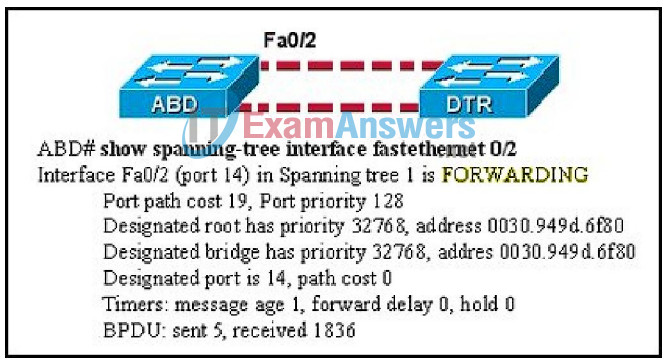
- The switch is sending and receiving data frames.
- The switch is receiving BPDUs, but not sending data frames.
- The switch is participating in an election process by forwarding the BPDUs it receives.
- The switch is receiving BPDUs and populating the MAC address table, but not sending data.
128. What are two benefits of the IEEE 802.11n standard over the IEEE 802.11G? (Choose two.)
- requires less equipment
- provides improved range
- permits increased data rates
- has a single-input and a single-output
- needs no hardware upgrade for compatibility
129. Refer to the exhibit. All hosts are in listen mode. Host 1 and Host 4 both transmit data at the same time. How do the hosts respond on the network? (Choose two.)
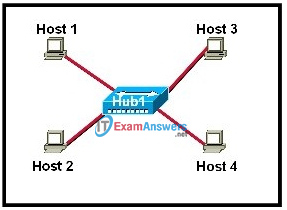
- After the end of the jam signal, a backoff algorithm is invoked.
- Hosts 1 and 4 are operating full duplex so no collision will exist.
- The hub will block the port connected to Host 4 to prevent a collision.
- Hosts 1 and 4 are assigned shorter backoff values to provide them priority to access the media.
- If a host has data to transmit after the backoff period of that host, the host checks to determine if the line is idle before transmitting.
130. What is an efficient and cost effective way to minimize the frequency and effects of broadcast storms on an Ethernet LAN?
- Connect each PC directly to a router port.
- Use access control lists to filter broadcasts from the network.
- Divide the computers into separate VLANs on the existing switches.
- Divide the computers into separate workgroups using different physical switches.
131. Which combination of DTP modes set on adjacent switches will cause the link to become an access link instead of a trunk link?
- dynamic desirable – trunk
- dynamic auto – dynamic auto
- dynamic desirable – dynamic auto
- dynamic desirable – dynamic desirable
132. Refer to the exhibit. A network administrator needs to add IP phones to the network. To which devices should the IP phones connect?
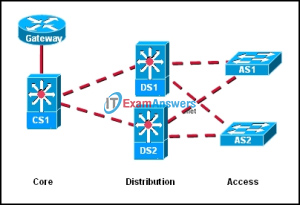
- AS1 and AS2
- DS1 and DS2
- DS1, DS2, and CS1
- AS1, AS2, DS1, and DS2
133. Refer to the exhibit. What does the term DYNAMIC indicate in the output that is shown?

- This entry can only be removed from the MAC address table by a network administrator.
- When forwarding a frame to the device with address 0060.5c5b.cd23, the switch does not have to perform a lookup to determine the final destination port.
- Only the device with MAC address 0060.5c5b.cd23 will be allowed to connect to port Fa0/18.
- The switch learned this MAC address from the source address in a frame received on Fa0/18.
134. Refer to the exhibit. Router R1 is properly configured for router on a stick inter-VLAN routing, but PC1 is unable to ping PC2. What needs to be done to resolve the problem?
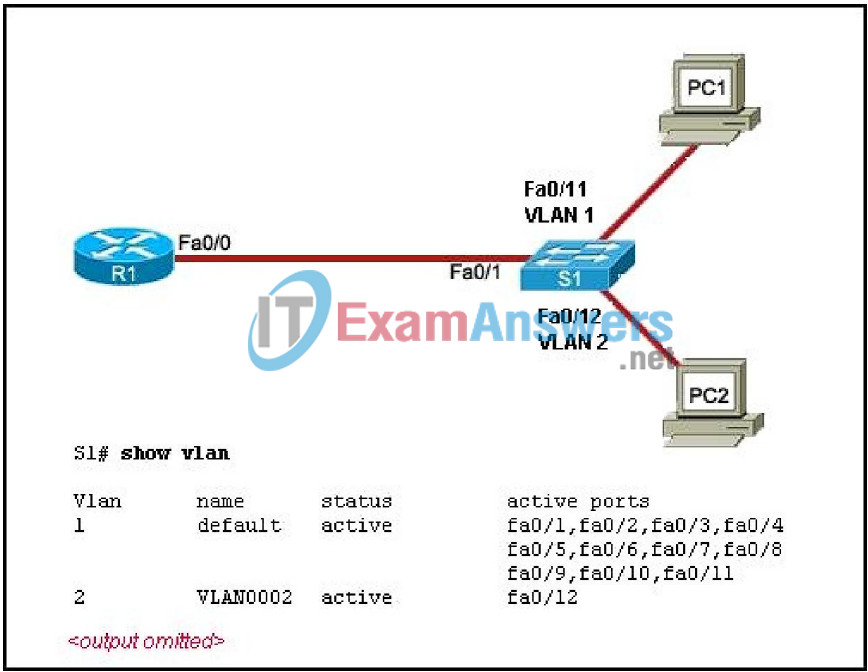
- Rename VLAN1.
- Connect one more port of S1 to R1.
- Configure the Fa0/1 port of S1 as a trunk port.
- Move the Fa0/0 interface of R1 to another VLAN.
135. Refer to the exhibit. What is the maximum number of VLANs that can be deleted from the Switch as it is configured?
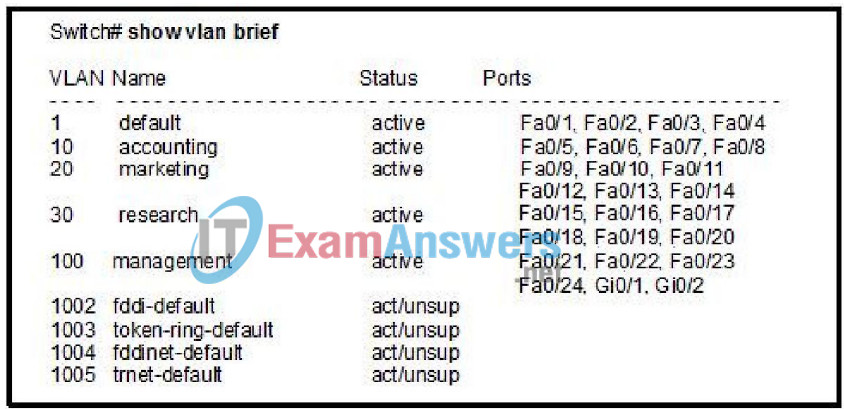
- zero
- four
- five
- eight
- nine
136. Refer to the exhibit. A new switch, SW3, has been added to the network. The network administrator determines that VLAN information is not propagating to SW3. Which command will remedy the problem?
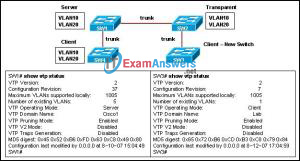
- SW1(config)# vtp version 1
- SW2(config)# vtp mode client
- SW3(config)# vtp domain Cisco1
- SW3(config)# vtp mode transparent
137. What advantage does cut-through switching provide?
- It enables QoS
- It forwards frames quickly.
- It provides an analysis of frames.
- It allows reduction of traffic by using error checking to drop corrupt frames.
138. Refer to the exhibit. The commands are entered into switch SW1 as shown, and an 802.1q trunk is successfully established. How does switch SW1 handle the untagged traffic that is destined for the trunk?

- SW1 will drop all untagged traffic.
- SW1 will send all untagged traffic to VLAN 1.
- SW1 will send all untagged traffic to VLAN 25.
- SW1 will send untagged traffic to all VLANs that are configured on the trunk.
139. Which service should be disabled on a Cisco switch or router to prevent packet sniffers from capturing information about the device?
- SSH
- VTP
- CDP
- SNMP
140. Which switch forwarding method should be used on a network that employs frame classification based on an assigned Quality of Service (QoS) value?
- cut-through
- fast-forward
- fragment-free
- store-and-forward
141. Refer to the exhibit. The broadcast traffic from PC1 is consuming bandwidth on the interswitch trunks. What should be done to prevent this from happening?
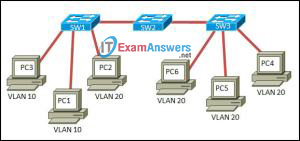
- Move PC1 to a port on SW3.
- Move PC2 to a port on SW3.
- Move PC1 to a port on SW2.
- Enable pruning for VLAN10 on the VTP server.
- Associate PC1 as a member of a new VLAN.
142. Refer to the exhibit. All switch interfaces are members of the same VLAN. What information is used by Switch1 to determine if incoming frames from the hosts should be forwarded to Router1?
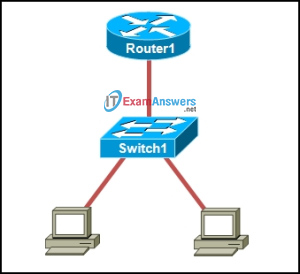
- the source address field in the IP header
- the destination port number in the TCP header
- the destination address field in the Layer 3 header
- the destination address field in the Ethernet header
143. Refer to the exhibit. Switch SWB is not responding to VTP updates from switch SWA. What is a possible cause of the problem?

- The VTP revision numbers are different.
- The number of existing VLANs is different.
- There is a password set on one of the switches.
- The enable passwords are not set on the switches.
144. Which IEEE trunking protocol is used to encapsulate data traffic over a trunk link on a Cisco switch?
- STP
- DTP
- VTP
- 802.1Q
145. When an access point is placed near the outside wall of a building, which implementation design procedure should be used?
- Disable SSID cloaking.
- Lower the encryption level.
- Decrease the power setting.
- Disable MAC address filtering.
- Modify the Network Mode to Wireless-G.
146. Refer to the exhibit. Although they are directly connected, switch SWA is not exchanging VLAN information with switch SWC. What can be done to correct this problem?

- Change the hostname of SWA to SWC.
- Change the hostname of SWC to SWA.
- Change the VTP version of SWA to version 1.
- Change the VTP operating mode of SWA to transparent.
147. Refer to the exhibit. A technician is troubleshooting a trunk problem between switches SW1 and SW2. What should be done to remedy the problem?

- “Negotiation of Trunking” on both switches should be turned off.
- “Administrative Mode” on switch SW1 should be configured as dynamic auto.
- “Trunking Native Mode VLAN” on switch SW2 should be configured as VLAN 100.
- “Operational Mode” on both switches should be configured as static access.
148. What allows WLAN clients to learn which networks and access points are available in an area?
- SSID
- probes
- beacons
- association
149. What technique is a security attack that depletes the pool of IP addresses available for legitimate hosts?
- reconnaissance attack
- DHCP spoofing
- DHCP snooping
- DHCP starvation
150. Refer to the exhibit. All edge ports are configured with the spanning-tree portfast command. Host1 is recently connected to port Fa0/1 on switch SW1. Which statement is true about the status of port Fa0/1?
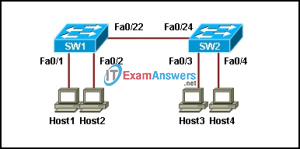
- The port will transition into blocking state.
- The port will transition immediately into forwarding state.
- The port will transition into blocking state and then immediately into forwarding state.
- The port will transition into blocking state and immediately transition through the listening and learning states.
151. Which two devices can cause interference with the operation of a WLAN because they operate on similar frequencies? (Choose two.)
- copier
- AM radio
- television
- MP3 player
- cordless phone
- microwave oven
152. What is a result of improperly implementing a network with redundancy at Layer 2?
- an increase of unicast and multicast errors at Layer 3
- a decrease in the amount of broadcast traffic
- end device malfunction because of broadcast storms
- an increase in throughput at all points in the network
153. Which statement is correct about STP architecture?
- Spanning Tree Protocol will guarantee a loop free Layer 2 topology.
- Spanning Tree Protocol guarantees the shortest path to destination networks.
- The switch with the highest priority will be assigned the lowest BID in the root election.
- The first step in the spanning-tree election process is to determine the root port.
- To select designated ports, the spanning-tree algorithm must determine the longest contiguous path from the root bridge.
154. Which statement is true about open authentication when it is enabled on an access point?
- requires no authentication
- uses a 64-bit encryption algorithm
- requires the use of an authentication server
- requires a mutually agreed upon password
155. Refer to the exhibit. The devices in the network are operational and configured as indicated in the exhibit. However, hosts A and D cannot ping each other. What is the most likely cause of this problem?

- The link between the switches is up but not trunked.
- The Fa0/11 interface of Switch1 is not configured as a trunk.
- Hosts A and D are configured with IP addresses from different subnets.
- VLAN 20 and VLAN 30 are not allowed on the trunk between the switches.
156. Refer to the exhibit. What does STATIC indicate in the output that is shown?

- Switch port Fa0/24 can only work in VLAN 99.
- VLAN 99 was manually added to the VLAN database.
- MAC address 0001.637b.b267 was learned from the source address of a frame that was received on switch port Fa0/24.
- MAC address 0001.637b.b267 was manually associated with the switch port Fa0/24.
157. Refer to the exhibit. A network administrator configures HyperTerminal with the parameters shown but is unable to connect to a switchvia the console port. The administrator is using a tested rollover cable attached to the only COM port on the computer, and theconnections have been verified. What is the likely problem?
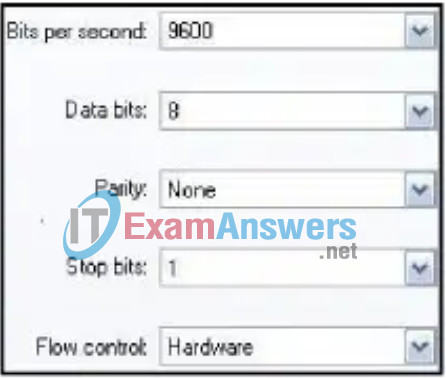
- The cable is connected to the wrong port.
- The wrong connection speed is selected.
- The cable is the wrong type.
- The flow control setting is not correct.
- The stop bits should be set to zero.
158. When configuring a router to act as an SSH server, what should be configured before issuing the crypto key generate rsa command?
- the security domain name
- the VTP domain name
- the IP domain name
- the host name
159. Refer to the exhibit. Which switch will be elected as the root bridge of the spanning tree topology?
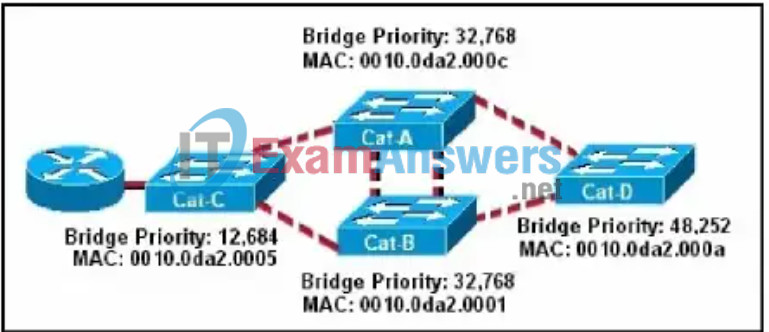
- Cat-A
- Cat-B
- Cat-C
- Cat-D
160. Which statement about STP network diameter is correct?
- STP diameters are restricted by convergence times.
- Layer 2 root elections should be optimized by adjusting BPDU timers to match network diameter.
- Using lower bandwidth connections between switches will allow STP to have a larger network diameter.
- Portfast can be used to increase the allowable switched network diameter because it disables the forward delay and maximum agetimers.
161. Which statement correctly describes the spanning-tree path cost?
- It is calculated based on the total number of switches connected in a loop.
- It is calculated based on the utilization of all the switches along a given path.
- It is calculated based on the bridge priority of the switches along a given path.
- It is calculated based on the sum of the port cost value, determined by link speed, for each switch port along a given path.
162. Refer to the exhibit. Computer D sends a broadcast message. Which devices will process the broadcast message?
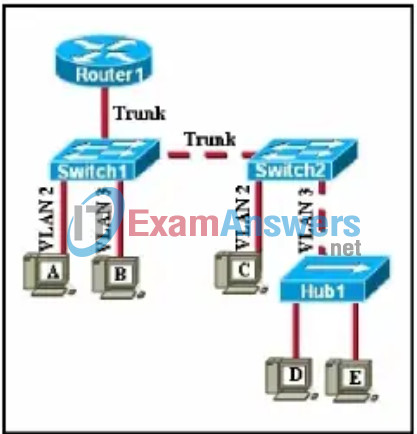
- computer E
- computer D and computer E
- computer D, computer E, and Router1
- computer B and computer E
- computer B, computer E, and Router1
- computer C, computer D, and computer E
- computer C, computer D, computer E, and Router1
- computer A, computer B, computer C, computer D, computer E, and Router1
163. Refer to the exhibit. Router R-West and switch S-West1 are connected via a single ethernet cable between the router interface fa0/0 andthe switch interface fa0/1. The router and switch have been configured with the commands that are displayed in the exhibit. The networkadministrator enters the show interfaces trunk command and receives the output as shown. What is the cause of the “not-trunking”status for switch port Fa0/1?
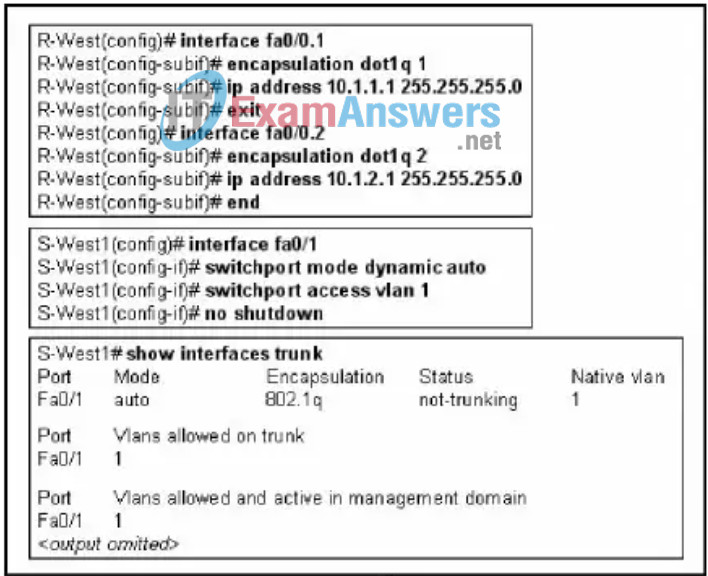
- The trunk is established, but no VLANs have been configured to use it.
- The router is missing the dynamic trunking protocol statements necessary to form a trunk.
- Because the router does not support Dynamic Trunking Protocol, the trunk has not been established.
- The router, the switch, or both must be configured with the dynamic desirable option for Dynamic Trunking Protocol to establish atrunk.
164. Refer to the exhibit. What is true of the configuration of switch S1?
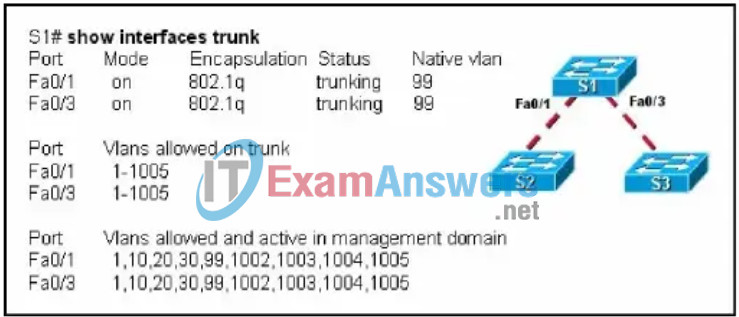
- A Cisco proprietary protocol is in use for ports Fa0/1 and Fa0/3.
- Switch ports Fa0/1 and Fa0/3 have been configured with the switchport mode access command.
- Untagged frames received on ports Fa0/1 and Fa0/3 will be placed on VLAN 1.
- Switch ports Fa0/1 and Fa0/3 are configured to carry data from multiple VLANs.
165. Refer to the exhibit. Switch SW2 was tested in a lab environment and then inserted into a production network without reloading its configuration. After the trunk link between SW1 and SW2 was brought up, all users lost connectivity to the network. What could be the source of the problem?

- All the VLANs were pruned from the trunk port between SW1 and SW2.
- SW1 and SW2 cannot be both set as VTP servers in the same VTP domain.
- VTP configuration revision number of SW2 was higher than the configuration revision number of SW1.
- The additional VLANs from SW2 created more VLANs than the VLAN database of SW1 could contain.
166. Refer to the exhibit. Switch SW2 has been newly purchased and added to the network. What configuration should be applied to SW2 so that it participates in the same VTP domain as switch SW1, receives VLAN information from SW1, and synchronizes VLAN information?
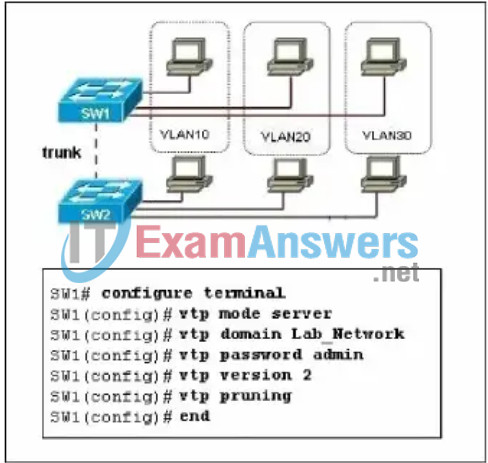
- Disable VTP pruning on SW2.
- Configure SW2 in VTP transparent mode.
- Configure SW2 with the VTP domain password.
- Configure SW2 as a VTP server with a higher revision number.
167. What two methods can be used to remove MAC address table entries from a switch? (Choose two.)
- Power cycle the switch to clear all dynamically learned addresses.
- The clear switching-tables command will remove statically configured entries.
- The clear mac-address-table command will remove statically and dynamically configured table entries.
- The erase flash command will clear all statically configured table entries.
- Statically configured MAC addresses will automatically be removed from the address table 300 minutes after the last activity on a switch port.
168. Refer to the exhibit. All switches are configured with the default bridge priority. Which port will act as a non-designated port if all links are operating at the same bandwidth?
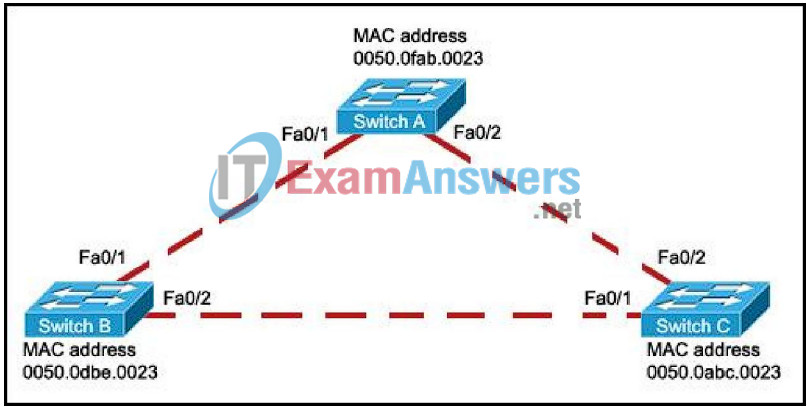
- Fa0/1 interface of switch A
- Fa0/2 interface of switch A
- Fa0/1 interface of switch B
- Fa0/2 interface of switch B
- Fa0/1 interface of switch C
- Fa0/2 interface of switch C
169. Refer to the exhibit. Which three options correctly describe the router configuration that is shown? (Choose three.)
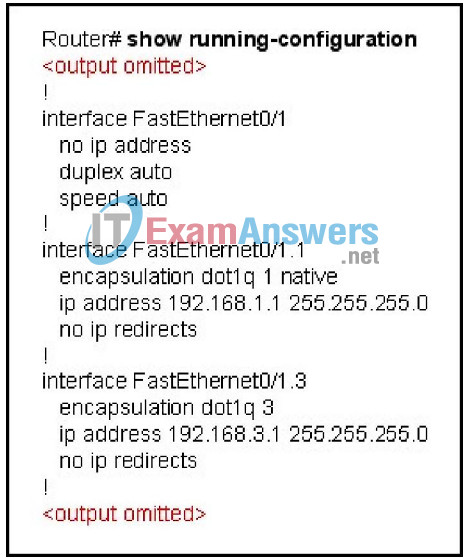
- An IEEE standard trunking protocol is in use.
- Interface Fa0/1 has been configured with subinterfaces.
- The shutdown command has been applied to interface Fa0/1.
- Interface Fa0/1.3 is mapped to the default management VLAN.
- The configuration is appropriate for a router-on-a-stick network design.
- An IP address should be applied to interface Fa0/1 for routing to occur.
170. Refer to the exhibit. The network administrator has just added VLAN 50 to Switch1 and Switch2. Hosts A, B, C, and D are correctly configured with IP addresses in the subnet range for VLAN 50. Host A can communicate with host B, but cannot communicate with host C or host D. What is the cause of this problem?
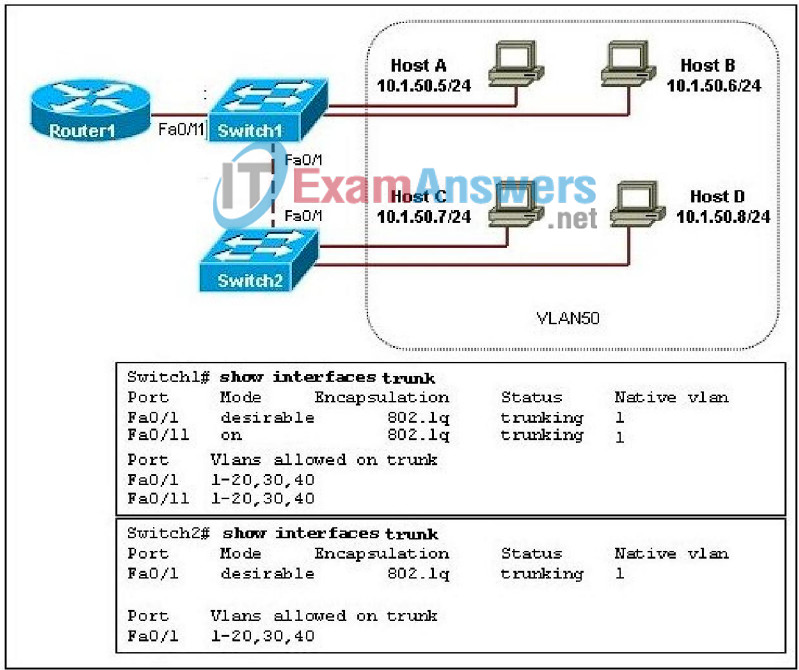
- There is a native VLAN mismatch.
- The Fa0/11 interface of Switch1 is not configured as a trunk.
- The link between Switch1 and Switch2 is up but not trunked.
- VLAN 50 is not allowed on the trunk link between Switch1 and Switch2.
171. What are three benefits of employing a hierarchical network design? (Choose three.)
- Hierarchically designed networks can more easily be expanded to suit future needs.
- Hierarchical design models enhance existing bandwidth through the use of link aggregation.
- The hierarchical model allows for specialized functionality at each layer, simplifying device management.
- Use of a hierarchical design allows replacement of redundant devices with high-capacity network equipment.
- A hierarchical design uses firewalls instead of complicated port-based and distribution layer security policies.
- The hierarchical model allows the use of high-performance switches at all design layers, thus allowing for a fully-meshed topology.
172. Refer to the exhibit. What will happen when frames with a source address other than 0019.d2e4.d9f7 enters interface Fa0/24?

- Fa0/24 will become error-disabled.
- The incoming frames will be dropped.
- The Fa0/24 port LED will be turned off.
- The security violation count will be incremented.
173. Refer to the exhibit. What is the purpose of the configuration commands that are shown?

- to activate port Fa0/10
- to make the port a member of VLAN 30
- to activate port security on port Fa0/10
- to add VLAN 30 to the trunk that is connected to port Fa0/10
174. Which type of frame contains information that is used in the election of the spanning tree root bridge?
- BID
- LSA
- LSU
- BPDU
175. Which device or devices should have the Spanning Tree Protocol enabled to prevent host traffic from creating a broadcast storm?
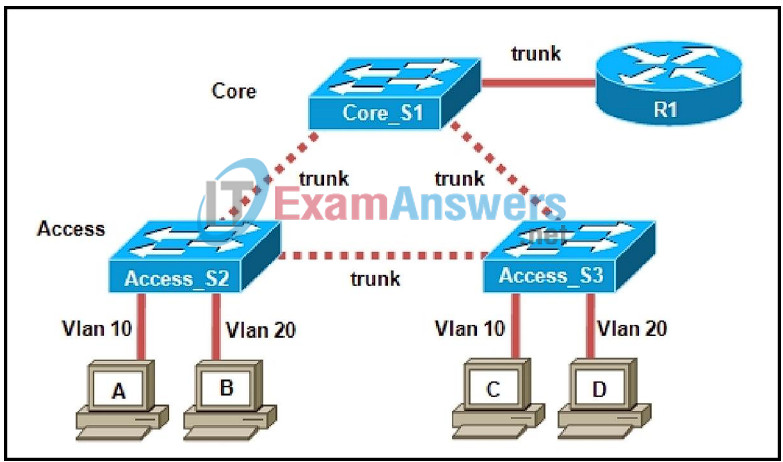
- Core_S1
- Access_S2 and Access_S3
- Core_S1, Access_S2, and Access_S3
- Core_S1, Access_S2, Access_S3, and R1
176. Refer to the exhibit. All trunk links are operational and all VLANs are allowed on all trunk links. An ARP request is sent by computer 5. Which device or devices will receive this message?
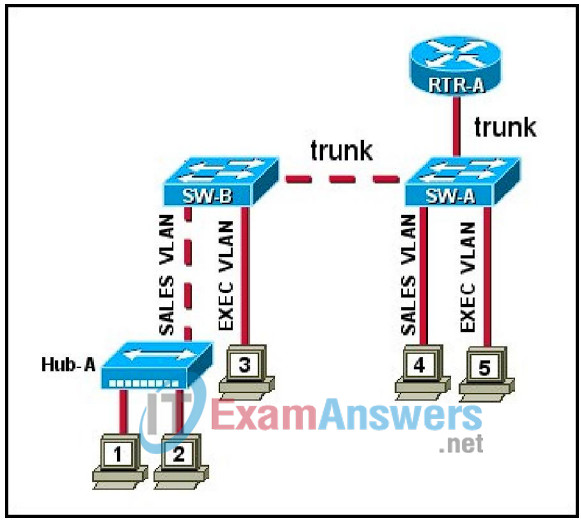
- only computer 4
- computer 3 and RTR-A
- computer 4 and RTR-A
- computer 1, computer 2, computer 4, and RTR-A
- computer 1, computer 2, computer 3, computer 4, and RTR-A
- all of the computers and the router
177. When implementing a router-on-a-stick, what must be configured on the router to ensure connectivity between different VLANs?
- subinterfaces
- routing protocol
- switched virtual circuits
- dynamic trunking protocol
178. Refer to the exhibit. After the listed commands are entered into router R1 and switch S1, the administrator enters the show interface fa0/1 trunk and gets the results shown. What is the likely problem?
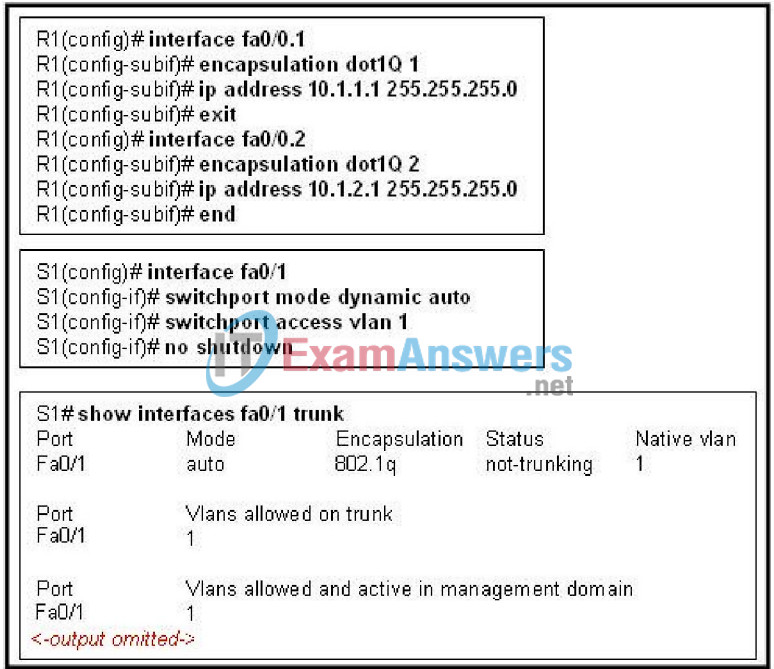
- The trunk is established, but no VLANs have been configured to use it.
- The router is missing the dynamic trunking protocol statements necessary to form a trunk.
- The trunk has not been established because the router does not support dynamic trunking protocol.
- The router, the switch, or both must be configured with the dynamic desirable option for dynamic trunking protocol to establish a trunk.
179. Refer to the exhibit. In what two ways will the router handle VLAN traffic that is received on the trunk? (Choose two.)
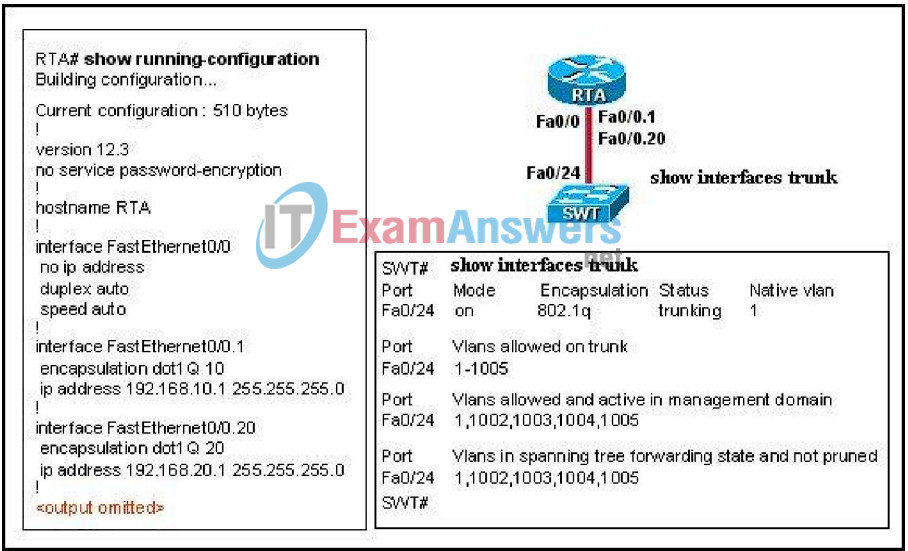
- Traffic to VLAN 1 received by the router interface Fa0/0 will be dropped by the router.
- Because interface Fa0/0 requires an IP address, the router will not be able to route between the VLANs.
- Packets that are received from network 192.168.20.0 /24 will be handled by subinterface Fa0/0.20.
- The router will use subinterface MAC addresses to identify the VLAN traffic that is received on the physical interface.
- The router will continue to process traffic from the attached VLANs even if the physical interface goes down.
180. Refer to the exhibit. What is true of the configuration of switch S1?

- Only VLAN 99 will be allowed to use the trunk links.
- Switch ports Fa0/1 and Fa0/3 are configured with a standard trunking protocol.
- Switch ports Fa0/1 and Fa0/3 should be configured as access ports to allow data from multiple VLANs to access switch S1.
- The switch negotiated trunk links for interfaces Fa0/1 and Fa0/3 because all connected interfaces have been configured with the switchport mode dynamic auto command.

Hashim how was it
4/11/2014 did my ccna 3 exam and i passed with 92% cool website….
Refer to the exhibit. After the listed commands are entered into router R1 and switch S1, PC1 and PC2 cannot ping each other. The network administrator enters the show interfaces trunk command and gets the results that are shown. What is the likely problem?
Refer to the exhibit. Computer A sends a broadcast message. Which devices will see the broadcast?
Refer to the exhibit. What will happen when frames with a source address other than 0019.d2e4.d9f7 enters interface Fa0/24?
Which statement correctly describes a function of a Layer 2 switch?
Refer to the exhibit. The configuration steps that are listed in the exhibit have been entered in switch S1 via the console. Subsequent attempts to telnet to the switch are not successful. What is causing the problem?
When implementing a router-on-a-stick, what must be configured on the router to ensure connectivity between different VLANs?
Which benefit is gained by designing a network with a small network diameter?
Refer to the exhibit. The switches are configured for VTP as shown. Which two statements correctly describe the operation of these switches? (Choose two.)
A network administrator is implementing a Layer 2 solution for a legacy network that uses a combination of switches. Many of the older devices support only ISL trunking while others support both ISL and 802.1Q trunking. Which STP variant would be best suited for this network?
Which two statements about a service set identifier (SSID) are true? (Choose two.)
Which layers should support QoS in a hierarchical network?
Refer to the exhibit. Which password allows the administrator to enter the privileged exec mode?
Which STP port type can only appear once on a segment, and must be present in order for traffic to flow on that segment?
In the implementation of PVST+ in a specific VLAN where all switches have default spanning tree priorities, which spanning-tree command setting could be assigned to force one of the Catalyst switches to become and remain the root bridge?
Refer to the exhibit. Which switch will be elected as the root bridge of the spanning tree topology?
Which switching method provides error-free data transmission?
Refer to the exhibit. What will allow a host that is connected to switch X in VLAN 10 to communicate with a host that is connected to switch Y in VLAN 10?
Refer to the exhibit. The network administrator is planning five additional VLANs to be shared throughout the VTP domain on S3. What action should the administrator take before creating the additional VLANs?
What is a possible impact of setting too short an aging time in the MAC address table of a switch?
Which parameter is associated with wireless authentication?
Which two statements describe Spanning Tree Protocol? (Choose two.)
Refer to the exhibit. Host A is sending a frame to host C. How does switch SWA tag the frame?
A network technician is investigating a problem on a switch that seems to have overflowing buffers and is dropping packets on many incoming ports. On examination the technician discovers that the problem exists because the destination port attaches to a busy server. What is the best way to address this problem?
Thanks for sharing. Your post is a useful couintbrtion.
Refer to the exhibit. Why must the NIC of host H1 operate in half-duplex mode?
Refer to the exhibit. Switch SW2 was tested in a lab environment and then inserted into a production network without reloading its configuration. After the trunk link between SW1 and SW2 was brought up, all users lost connectivity to the network. What could be the source of the problem?
Refer to the exhibit. What three statements describe why Host1 and Host2 are unable to communicate? (Choose three.)
Which device must be installed in each computer to allow a wireless connection to be established?
After unpacking a new Linksys WRT300N wireless multifunction device, a user needs to change the default administrator password and make other configuration changes. What must the user do to access the device in order to make these changes?
Refer to the graphic. In the Wireless menu option of a Linksys integrated router, what does the Network Mode option Mixed mean?
Refer to the exhibit. Switches SW3 and SW4 are brand new switches with default configurations. The links between the switches are configured as trunk links and all VLANs are allowed on the trunks. On the basis of the show running-config output that is provided, which VLANs will be available on SW3 and SW4?
How are data frames identified and sent to the correct VLAN when exiting an Ethernet trunk?
Refer to the exhibit. A company has acquired a new office in a campus environment. Switches in the existing office and the new office are directly connected by a trunk link. The VLANs and IP addressing are setup as shown in the exhibit. The computers in each office are not able to ping each other. What will fix the problem?
Refer to the exhibit. The network administrator configures both switches as displayed. However, host C is unable to ping host D and host E is unable to ping host F. What action should the administrator take to enable this communication?
Which type of frame contains information that is used in the election of the spanning tree root bridge?
Which statement regarding the service password-encryption command is true?
What provides an authentication mechanism for 802.11-based wireless networks?
Refer to the exhibit. After receiving a console notification on Switch2, the network administrator begins to troubleshoot the trunk link between Switch1 and Switch2. Which configuration change can be made to correct the problem with the trunk link?
Refer to the exhibit. A network administrator needs to download a previously saved configuration file from the TFTP server to Switch1. Which command will accomplish this task?
Refer to the exhibit. Host A is sending a frame to host C. How does switch SWA tag the frame?
A network administrator enables sticky learning on all access mode interfaces of a Catalyst switch, saves the configuration, then connects hosts to the switch. After the switch operates for several days, the administrator reboots the switch without saving the running configuration. What is the result?
Refer to the exhibit. What is true of the configuration of switch S1?
Which three statements accurately describe VLAN types? (Choose three).
A network technician notes that ports Fa0/9 through Fa0/12 on a switch have been assigned to VLAN 40. VLAN 40, however, was improperly named and the technician deletes it. What happens to the ports that were assigned to VLAN 40?
Refer to the exhibit. Switch SW2 has been newly purchased and added to the network. What configuration should be applied to SW2 so that it participates in the same VTP domain as switch SW1, receives VLAN information from SW1, and synchronizes VLAN information?
Refer to the exhibit. What is the purpose of the configuration commands that are shown?
Which statement accurately describes routing between VLANs when the default gateway addresses of the VLANs are applied to physical interfaces.
Refer to the exhibit. Switch1 is configured for VTP as shown. An administrator connects four switches to Switch1 and configures trunk links between them. Which of the four switches will successfully receive and install VTP updates from Switch1?
Some extra questions for ccna 3 exam
Refer to the exhibit. The switches are configured for VTP as shown. Which two statements correctly describe the operation of these switches? (Choose two.)
Which two statements about a service set identifier (SSID) are true? (Choose two.)
Which layers should support QoS in a hierarchical network?
Refer to the exhibit. Which password allows the administrator to enter the privileged exec mode?
In the implementation of PVST+ in a specific VLAN where all switches have default spanning tree priorities, which spanning-tree command setting could be assigned to force one of the Catalyst switches to become and remain the root bridge?
Refer to the exhibit. Which switch will be elected as the root bridge of the spanning tree topology?
Refer to the exhibit. What will allow a host that is connected to switch X in VLAN 10 to communicate with a host that is connected to switch Y in VLAN 10?
What is a possible impact of setting too short an aging time in the MAC address table of a switch?
Which two statements describe Spanning Tree Protocol? (Choose two.)
Which parameter is associated with wireless authentication?
This comment has been removed by the author.